I2AO Part 8a: The Solar System
Back to the Index of I2AO (Introduction to Astronomy Online)
PART 8a: THE SOLAR SYSTEM by Lesa Moore
This part will cover the Solar System in general. Selected moons of the Solar System are discussed separately in Part 8b and exploration by spacecraft is reviewed in Part 8c.
- Components of the Solar System
- Scale Models of the Sun and Planets
- The Sun
- Mercury
- Venus
- Earth
- Mars
- Terrestrial Planet Features
- The Asteroid Belt and Inner Asteroids
- Jupiter
- Saturn
- Uranus
- Neptune
- Gas Giant Features
- Dwarf Planets and Kuiper Belt Objects
- Pluto
- Comets
- Termination Shock
- Orbits and Ellipses
-----------------------------------------------------
1. Components of the Solar System
The Solar System encompasses the Sun and all bodies orbiting the Sun, as well as interplanetary gas and dust, and regions beyond that contain bodies yet to be discovered. This includes:
- Planets and dwarf planets, including recent discoveries and many yet-to-be discovered.
- Moons - these are the natural satellites that orbit planets or asteroids.
- Asteroids - these may be in the Main Asteroid Belt or the Kuiper Belt or may traverse other regions within the planetary orbits.
- Comets - similar to asteroids, but with more volatile constituents that vaporise when closer to the Sun.
- Meteoroids - all the left-over bits that haven't fallen into larger bodies.
- The Kuiper belt - a region beyond the orbit of Neptune that harbours asteroids.
- The Oort cloud - a region that extends about half-way to the nearest star and is believed to be the origin of many comets.
In brief overview:
- There is a LOT of empty space between the Sun and planets compared with their sizes.
- The four rocky inner planets are known as terrestrial planets.
- The large gaseous outer planets are known as gas giants.
- Pluto was classified as a dwarf planet in 2006.
- Through the ages, astronomers have argued about where the solar system ends. One opinion is that the boundary is where the Sun’s gravity no longer dominates - a point beyond the planets and beyond the Oort Cloud. This boundary is roughly about halfway to the nearest star, Proxima Centauri.
Figure 1.1 below - A Line-up of Planets: In this extraordinary collage, the separation between the Earth and the Moon is indicated by a bracket that reaches from the Earth, on the left-hand side, to the Moon, on the right-hand side. All the other planets (Mercury, Venus, Mars, Jupiter, Saturn, Uranus and Neptune), represented to scale, fit in the space between.
Image Credit: Compliation by Universe Today using separate images from NASA

2. Scale Models of the Sun and Planets
- Creating a complete scale model of the Solar System is quite difficult.
- On a diagram that shows distances to scale, such as Figure 2.1, below, it is impossible to show the sizes on the same scale (note also that the distances in that diagram are on an exponential scale).
- In Figure 2.2, below, the sizes are to scale, but there is no consideration of the distances.
- To give a true perspective of both sizes and distances, a physical model must show very small planets spaced out over rather large distances. Click on Figure 2.3 below to link to an online video of an accurate scale model (sizes and distances) that was made in the desert over a 7-mile range.
Figure 2.1 below - Diagram of Distances in the Solar System: The exponential distance scale extends from the Sun, through the planets, and far beyond to show the edge of the heliosphere (the region of influence of the solar wind), the vague boundaries of the Oort Cloud and the nearest star system to our Sun, Alpha Centauri. On this type of scale, every interval on the horizontal axis is actually ten times larger than the previous interval, i.e. the Sun-Earth distance is one astronomical unit (au), the Earth-Saturn distance is 10 au and the Saturn-heliopause distance is 100 au, and so on.
Image Credit: Phys.org, https://phys.org/news/2009-11-stars-destination.html
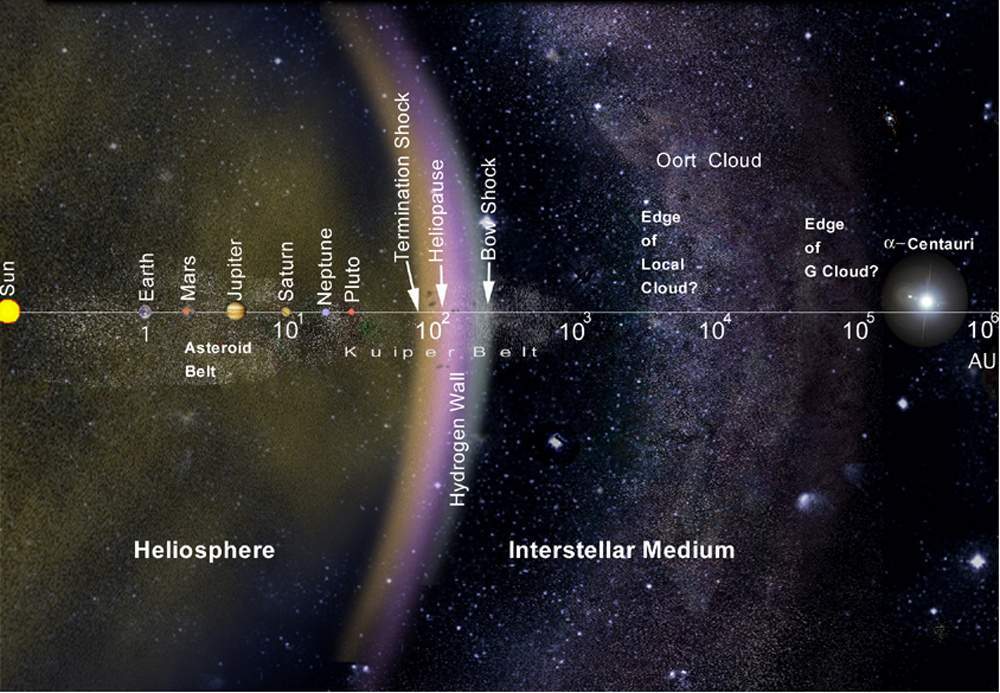
Figure 2.2 below - The Sun and Planets to Scale: Here, the Sun is the large orange ball and, in front of it, are the planets - Jupiter, Saturn, Uranus, Neptune, Earth, Venus, Mars and Mercury, all on the same scale.
Image Credit: Screenshot from YouTube video here: https://www.youtube.com/watch?v=T0RT4nFJEFM

Figure 2.3 below - A Full Scale Model of the Planets: Click on the link or the image to view the video.
Credit: The Atlantic, https://www.theatlantic.com/video/index/417309/our-place-in-the-universe/
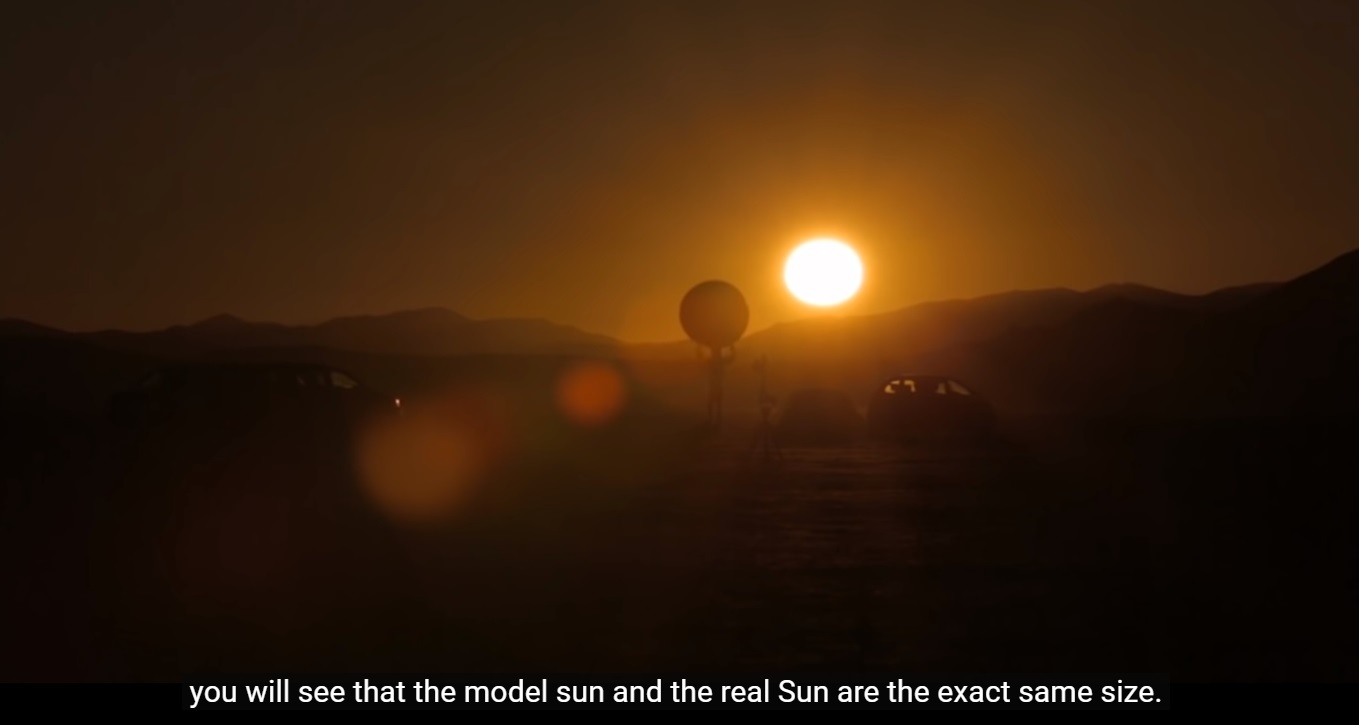
- The Sun is 1,392,000 km in diameter.
- The Sun contains 99.86% of the mass of the Solar System.
- The average distance to the Sun from Earth is approximately 150 million kilometres.
- Review more information about the Sun here.
- Exploration: The current (2020) mission observing the Sun is the Parker Solar Probe.
Figure 3.1 below - Mercury and the International Space Station transit the Sun: This composite follows the space station, moving from upper right to lower left, as it crossed the Sun's disk in 0.6 seconds. Mercury is the small, round, silhouette just below center. In apparent size, the International Space Station looms larger from low Earth orbit, about 450 kilometers up. Mercury was about 84 million kilometers away.
Image Credit: Thierry Legault on Astronomy Picture of the Day https://apod.nasa.gov/apod/ap160513.html
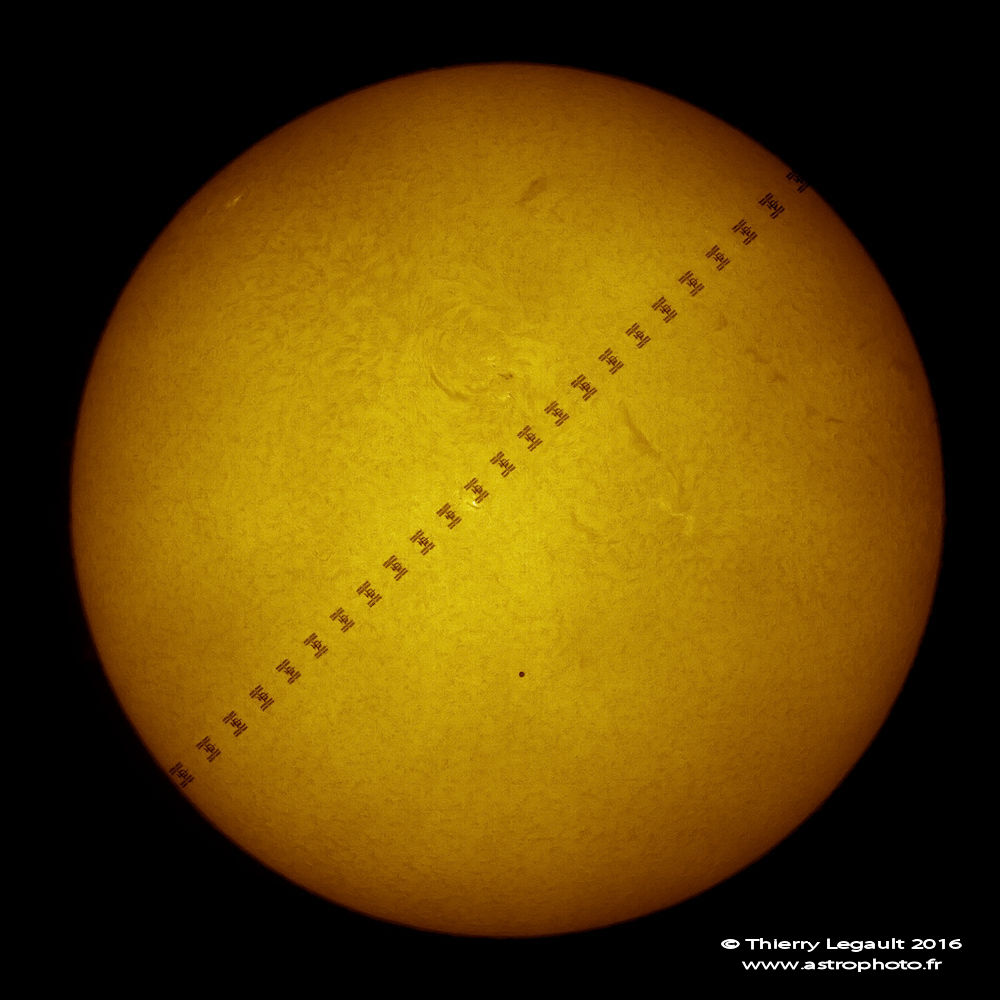
4. Mercury
Quick facts about Mercury:
- Diameter: 4880 km
- Average distance from the Sun: 58 million km, 0.4 astronomical units (AU)
- Structure: Solid silicate crust and mantle overlying a solid, iron sulfide outer core layer, a deeper liquid core layer, and a solid inner core.
- Atmosphere: Thin exosphere - oxygen (O2), sodium (Na), hydrogen (H2), helium (He), and potassium (K). Atoms that are blasted off the surface by the solar wind and micrometeoroid impacts create Mercury's exosphere.
- Length of day: 59 Earth days
- Period of orbit: 88 Earth days
- Neat stuff: One day-night cycle on Mercury takes 175.97 Earth days. Because Mercury has no axial tilt, ice accumulates in craters at the poles.
- Moons: None
- Exploration: Mariner 10 - NASA Flyby Mission to Venus and Mercury (1973); MESSENGER - NASA Orbiter to Mercury (2004); BepiColombo - ESA/JAXA Orbiter Mission to Mercury (2018).
Figure 4.1 below - Mercury's Interior: Mercury has a crust, core and mantle like the Earth.
Image Credit: NASA

Figure 4.2 below - Mercury's Surface in Colour: The surface of Mercury is cratered and mainly grey, like Earth's Moon. Subtle colour variations are visible in this image from MESSENGER.
Image Credit: NASA MESSENGER Image Gallery

5. Venus
Quick facts about Venus:
- Diameter: 12,100 km
- Average distance from the Sun: 108 million km, 0.7 AU
- Structure: Venus has an iron core that is approximately 6,400 km in diameter. Above that is a mantle made of hot rock slowly churning due to the planet's interior heat. The surface is a thin crust of rock that bulges and moves as Venus' mantle shifts and creates volcanoes. Figure 5.1, below, shows the interior structure.
- Atmosphere: A view through a telescope shows only a dense, pearly white atmoshpere. The atmosphere of Venus is mainly carbon dioxide, with clouds of sulfuric acid droplets or vapour. The thick atmosphere traps the Sun's heat in a runaway greenhouse effect, resulting in surface temperatures higher than 470 degrees Celsius (hot enough to melt lead). The atmospheric pressure at the surface is almost a hundred times that at the Earth's surface. Figure 5.2, below, was taken from the surface of Venus. In figure 5.3, below, atmospheric detail may be seen using an ultraviolet filter. To penetrate the atmosphere, radar was used to create a global surface map (Figure 5.4 below). The high atmospheric pressure contributes to the unusual volcanology, such as the pancake domes in Figure 5.5. The high refractive index of the atmosphere means that if you look straight ahead, you don't see the horizon - it would be way above your head, if visible at all.
- Length of day: 243 Earth days
- Period of orbit: 225 Earth days
- Neat stuff: Because of its fearsome atmosphere, you would be simultaneously cooked, crushed, asphyxiated and dissolved on Venus. Don't go there for a holiday! One day-night cycle takes 117 Earth days because Venus spins in the direction opposite to its orbit around the Sun (retrograde). Observing a Transit of Venus was proposed by Edmund Halley as a method of measuring the distance between the Earth and the Sun (refer Figure 5.6 below); the technique was used in 1874 but data had large margins of error due to the black drop effect (refer Figure 5.7 below). It was on his way back from his transit observation in Tahiti that Captain Cook mapped the east coast of Australia.
- Moons: None
- Exploration: BepiColombo - ESA Mercury Orbiters and Lander (2018) (2 Venus Flybys); Parker Solar Probe - NASA Solar Mission (2018) (Multiple Venus Flybys); Akatsuki/Planet-C (IKAROS) - ISAS Venus Orbiter (2010); Venus Express - ESA Venus Orbiter (2005-2014); MESSENGER - NASA Mercury Orbiter (2004) (Two Venus Flybys); Magellan - NASA Venus Radar Mapping Mission (1989-1994); Pioneer Venus - NASA Orbiter/Probes to Venus (1978-1992); Galileo - NASA Mission to Jupiter (Venus Flyby - 1990); Vega 1 - Soviet mission to Venus and Comet Halley (Venus Flyby - 1985); Vega 2 - Soviet mission to Venus and Comet Halley (Venus Flyby - 1985); The Venera series including Venera 7, Venera 13 and 14 - Soviet Venus Missions (1961-1983); Mariner 10 - NASA Mission to Venus and Mercury (1973-1975); Mariner 5 - NASA Venus Flyby (1967); Mariner 2 - NASA Venus Flyby (1962).
Figure 5.1 below - The Interior of Venus: It is not known if Venus's core has yet solidified in the same way as much of the Earth's core has. Because of its slow rotation (243 days) and its predicted lack of internal thermal convection, any liquid metallic portion of its core could not be rotating or convecting fast enough to generate a measurable planetary magnetic field. - https://sunearthday.nasa.gov/2012/transit/venus.php
Image Credit: Calvin J. Hamilton

Figure 5.2 below - First Colour Image of the Surface of Venus: The Venera 13 lander made colour images on the surface of Venus. Two were compiled for this panorama. The camera lens was made from quartz, as glass would have simply melted. In any case, landers on Venus don't last very long (up to two hours).
Image Credit: NASA

Figure 5.3 below - The Atmosphere of Venus seen in Ultraviolet: The Pioneer Venus mission consisted of an orbiter and probe, launched separately. This image of the clouds was from the orbiter in 1979.
Image Credit: NASA/Pioneer Venus Orbiter

Figure 5.4 below - The Surface of Venus: Because the surface of Venus can't be seen from orbit with ordinary cameras, it was mapped by the Magellan orbiter using radar. It works something like the radar used to check your speed, where the speed camera is fixed and the change in the return time for the radar beam can be used to measure the speed of a vehicle. In the case of surface mapping, the orbiter height is known and the change in the return time for the radar beam is used to measure the change in height of the surface features below.
Image Credit: NASA/Magellan
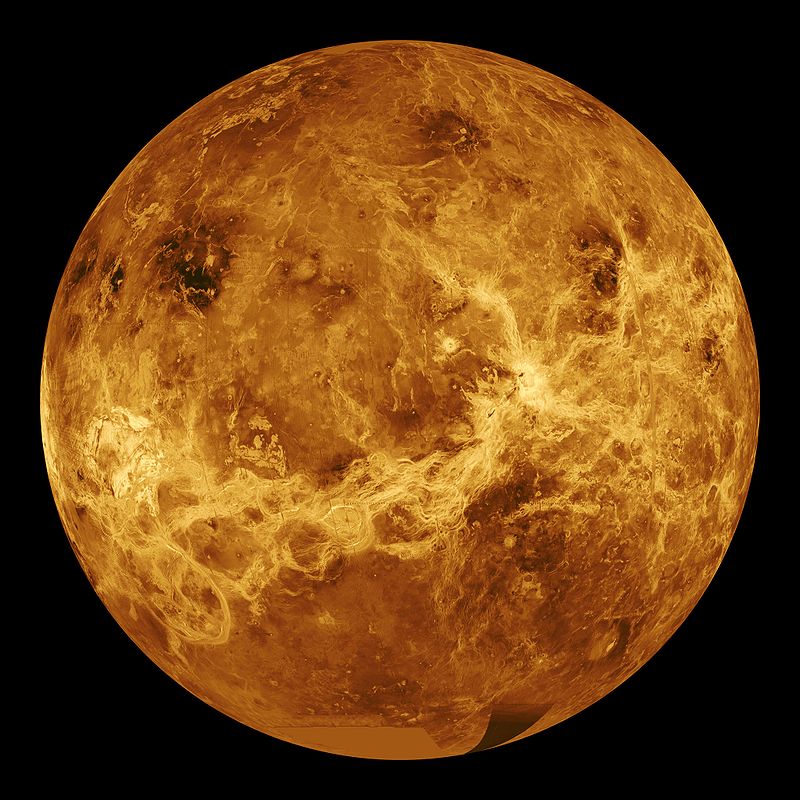
Figure 5.5 below - Pancake Domes on Venus: Venus has more volcanoes than any other body in the Solar System. The activity of these volcanoes is unknown. The shape of the volcanic mountains is not peaked like on Earth, but squished into pancakes, due likely to less rigidity in the crust materials (because of the high surface temperature) and the high atmospheric pressure.
Image Credit: NASA/Magellan
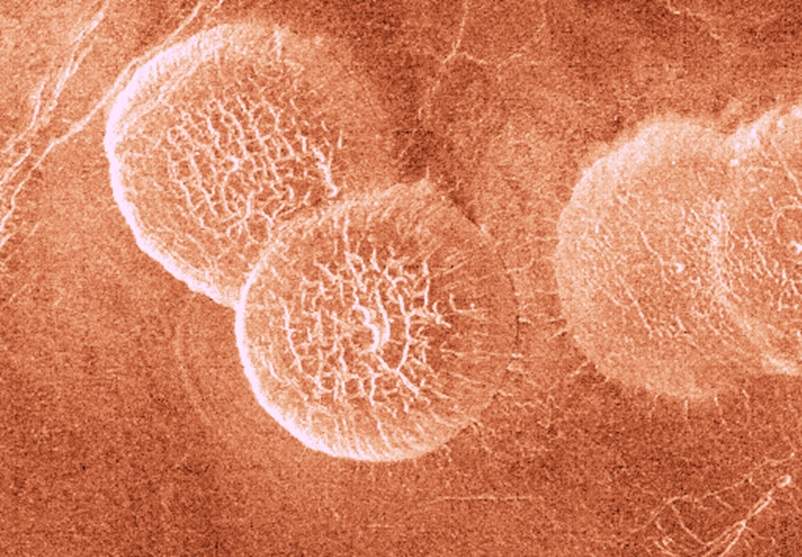
Figure 5.6 below - Diagram of how to measure a Transit of Venus: By carefully timing when line-of-sight points of contact between Venus and the limb of the Sun occur, from a number of different points on the surface of the Earth (giving known baselines), and using lots of maths, it is possible to calculate the angles needed to triangulate the distance between the Earth and the Sun.
Image Credit: Drawing published 1873 for the 1874 Transit of Venus

Figure 5.7 below - The Black Drop Effect: Attempts to accurately time the contacts of Venus with the Sun's limb were confounded by the "black drop effect" - an effect due to telescope optics and atmospherics - that makes it impossible to determine exactly with Venus makes contact with or separates from the Sun's edge.
Image Credit: Juan Carlos Casado
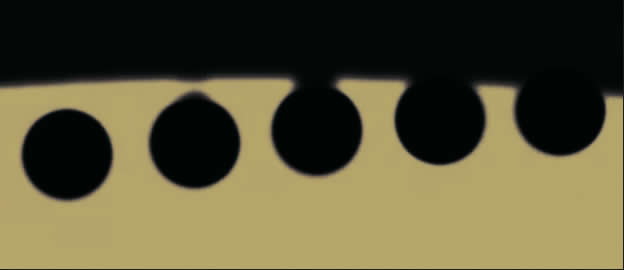
6. Earth
Quick facts about Earth:
- Diameter: 12,756 km
- Average distance from the Sun: 150 million km, 1 AU
- Structure: Solid inner core, liquid outer core, semi-liquid mantle, solid crust
- Atmosphere: 78% nitrogen, 21% oxygen 0.97% argon, 0.04% carbon dioxide, trace amounts of other gases, and 0.4% water vapour
- Length of day: 24 hours
- Period of orbit: 365.25 days
- Neat stuff: There are countless remote sensing satellites that are making measurements of the atmosphere, oceans, land and cryosphere. NASA is enabling more studies than ever before of our home planet and how it is evolving, and all this information is accessible in the NASA Space Science Data Coordinated Archive (NSSDCA). Review the I2AO notes about the Earth here.
- Moons: One actual permanent moon, the Moon. Review the I2A notes about the Moon here. Also read about the Moon, a transient moon (2020CD3), and an Earth "trojan" (2010TK7) on the I2AO "Moons" page here.
- Earth-Observing Satellites: Some 1500 working satellites are in orbit around the Earth. Historic and current satellites and an unsuccessful launch discussed in I2AO Part 8c are: Sputnik, Vanguard, Explorer 1, Ariel 1, Syncom and Himawari.
- Orbiting Observatories: GALEX, Kepler, WMAP, Spitzer, Lisa Pathfinder, Chandra, Hubble Space Telescope.
- Lunar Exploration: Chandrayaan 2 - ISRO (India) Lunar Orbiter, Lander and Rover Mission (2019); Beresheet - Space IL and Israeli Aerospace Industries (Israel) Lunar Lander (2019); Chang'e 4 - CNSA (China) Lunar Farside Lander (2018); Chang'e 3 - CNSA (China) Lunar Lander and Rover (2013); LADEE - NASA Lunar Orbiter Dust Environment Mission (2013); GRAIL - NASA Lunar Orbiter Mission (2011); Chang'e 2 - CNSA Lunar Orbiter Mission (2010); ARTEMIS-P1 and ARTEMIS-P2 - NASA Heliophysics/Lunar Orbiter Mission (2010); Lunar Reconnaissance Orbiter - NASA Lunar Orbiter Mission (2009); LCROSS - NASA Lunar Impactor Mission (2009); Chandrayaan-1 - ISRO (India) Lunar Orbiter Mission (2008); Cháng’é 1 - CAST (China) Lunar Orbiter Mission; Kaguya (SELENE) - JAXA Lunar Orbiter Mission; Deep Impact/EPOXI - NASA Mission to Comet Tempel 1 - Lunar Flyby; SMART 1 - ESA Lunar Orbiter Mission; Lunar Prospector - NASA Lunar Discovery Mission; AsiaSat 3/HGS-1 - Commercial Telecommunications Satellite; Clementine - DoD/NASA Lunar Mapping Mission; Hiten - ISAS Lunar Flyby and Orbiter; Galileo - NASA Mission to Jupiter - Lunar Flyby; Apollo - NASA Lunar Manned Missions (six landings 1969-1972); Lunar Orbiter - NASA Lunar Mapping Missions; Surveyor - NASA Lunar Lander Missions; Ranger - NASA Lunar Impact Missions; Soviet Lunar Missions including Luna 2, Luna 3, Luna 9, Luna 16, Luna 17 with the rover, Lunokhod in the Luna series, and the Zond missions.
Figure 6.1 below - Earth's Interior: At the heart of our planet lies a solid iron ball, about as hot as the surface of the Sun. It spins at its own rate, as much as 0.2o of longitude per year faster than the Earth layers above it. Surrounding the iron ball is an ocean of liquid iron - the outer core. Surrounding the core is the mantle, and Earth's crust forms the top layer. Earth's magnetic field comes from the outer core's ocean of iron, which is an electrically conducting fluid in constant motion. The magnetic field waxes and wanes, the poles drift and, occasionally, flip. Included in the diagram is the movement of magnetic north from 1900 to 1996. - https://www.nasa.gov/mission_pages/sunearth/news/gallery/earths-dynamiccore.html
Image Credit: NASA/Dixon Rohr
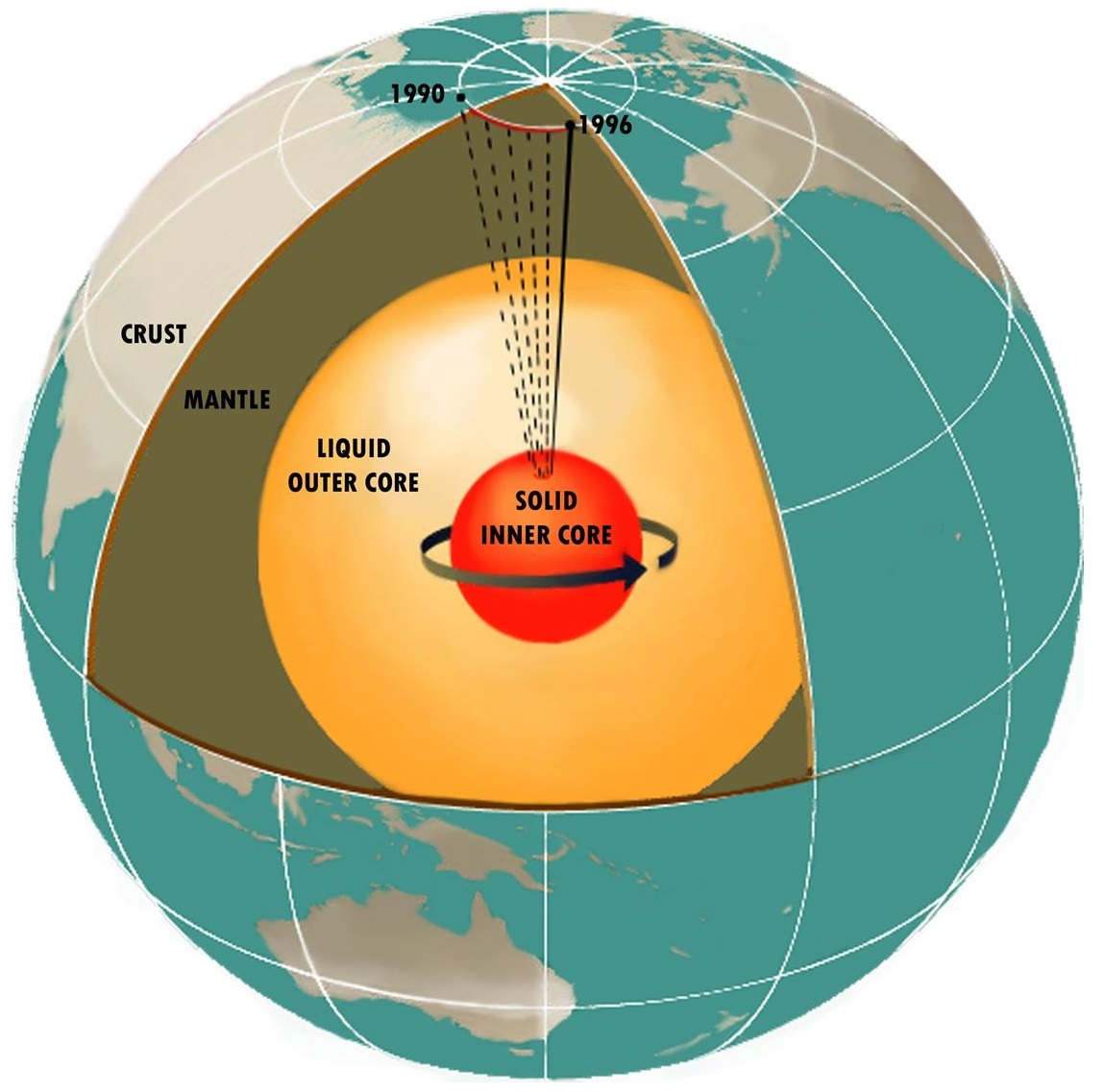
Figure 6.2 below - Earth at Night: This composite image, which has become a popular poster, shows a global view of Earth at night, compiled from over 400 satellite images. NASA researchers have used these images of nighttime lights to study weather around urban areas. - https://www.nasa.gov/topics/earth/earthday/gall_earth_night.html
Image Credit: NASA/NOAA

Figure 6.3 below - Earthrise from Apollo 8: Apollo 8, the first manned mission to the moon, entered lunar orbit on Christmas Eve, Dec. 24, 1968. That evening, the astronauts - Commander Frank Borman, Command Module Pilot Jim Lovell, and Lunar Module Pilot William Anders - held a live broadcast from lunar orbit, in which they showed pictures of the Earth and moon as seen from their spacecraft. Said Lovell, "The vast loneliness is awe-inspiring and it makes you realize just what you have back there on Earth." They ended the broadcast with the crew taking turns reading from the book of Genesis. - https://www.nasa.gov/multimedia/imagegallery/image_feature_1249.html
Image Credit: NASA, William Anders
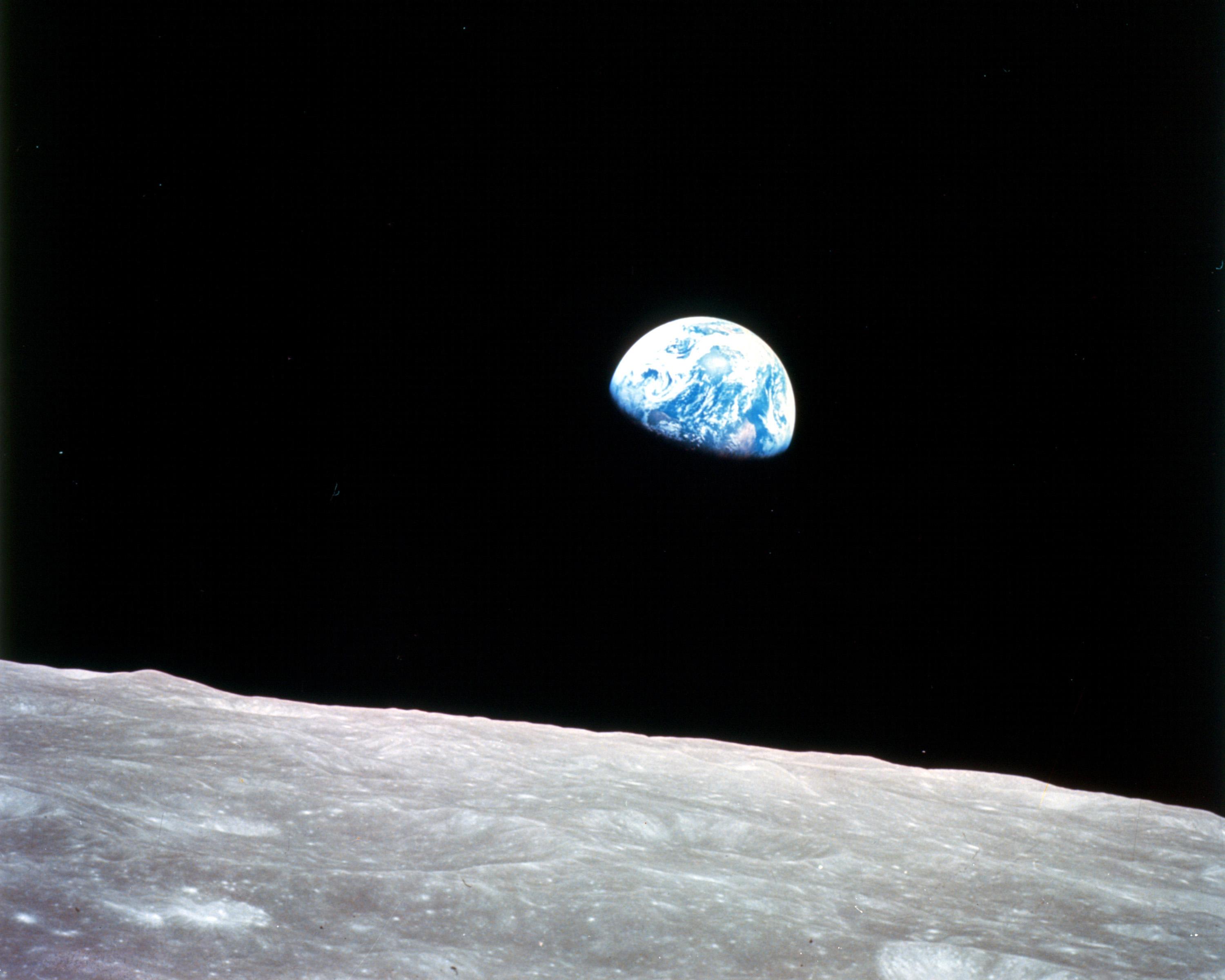
7. Mars
Quick facts about Mars:
- Diameter: 6787 km
- Average distance from the Sun: 228 million km, 1.5 AU
- Structure: Core, mantle and thick, inactive crust (refer Figure 7.1 below)
- Atmosphere: Carbon Dioxide (CO2) 95.1%; Nitrogen (N2) 2.59%; Argon (Ar) 1.94%; Oxygen (O2) 0.16%; Carbon Monoxide (CO) 0.06%. Pressure less than 1/100th of Earth's atmospheric pressure at the surface. Mars has global dust storms (refer Figure 7.2 below) and dust devils (refer Figure 7.3 below).
- Length of day: 24.6957 hrs
- Period of orbit: 779.94 days
- Neat stuff: Mars is the only planet whose solid surface can be seen through a telescope. Mars has the largest canyon in the Solar System, Mariner Valley (visible in Figure 7.4 below) and the largest volcano in the Solar System, Olympus Mons (Figure 7.5 below). Horizontal layering is seen in rocks on Mars (as in Figure 7.6 below) suggesting sedimentary processes were at work in the past. The Curiosity rover found a nickel-iron meteorite on Mars (refer Figure 7.7 below). Figure 7.8 shows different ways of interpreting colours on Mars. Known as the "red planet", it is red because the rocks are red (high iron oxide content - like rust). But note that the sky is also red from dust in the atmosphere!
- Moons: Phobos, Deimos
- Exploration: InSight - NASA lander to Mars (2018), ExoMars 2016 - ESA Orbiter and Lander to Mars (2016), MAVEN - NASA Mars Orbiter (2013), Mangalyaan - ISRO (India) Mars Orbiter (2013), NASA Mars Science Laboratory (Curiosity) - NASA Mars Rover (2011), Phobos-Grunt - Attempted Russian Phobos Sample Return (2011), Yinghuo-1 - Attempted Chinese Mars Orbiter (2011), Phoenix - NASA Mars Scout Lander (2007), Mars Reconnaissance Orbiter - NASA Orbiter (2005), Mars Exploration Rovers - Two NASA Rovers to Mars (2003) - Spirit & Opportunity, Mars Express - ESA Mars Orbiter and Lander (2003), 2001 Mars Odyssey - NASA Orbiter Mission to Mars (2001), Mars Polar Lander - NASA attempted lander to Mars (1999), Deep Space 2 - NASA attempted penetrator mission to Mars (1999), Mars Climate Orbiter - NASA attempted orbiter to Mars (1998), Nozomi (Planet-B) - ISAS (Japan) orbiter to Mars (1998), Mars Global Surveyor - NASA Mars orbiter (1996), Mars Pathfinder (and Sojourner)- NASA lander and rover to Mars (1996), Mars 96 - Russian attempted mission to Mars (1996), Mars Observer - NASA attempted mission to Mars (1992), Phobos - Soviet missions to Mars (1988), Viking - NASA orbiters/landers to Mars (1975), Mars 7 - Soviet attempted Mars lander (1973), Mars 6 - Soviet Mars lander (1973), Mars 5 - Soviet Mars orbiter (1973), Mars 4 - Soviet attempted Mars orbiter (1973), Mariner 9 - NASA Mars orbiter (1971), Mars 3 - Soviet Mars orbiter and lander (1971), Mars 2 - Soviet Mars orbiter and lander (1971), Mariner 7 - NASA Mars flyby (1969), Mariner 6 - NASA Mars flyby (1969), Mariner 4 - NASA Mars flyby (1964), Mars 1 - Soviet Mars flyby (1962)
Figure 7.1 below - Interior of Mars Current models of the planet’s interior imply a core region about 1,794 km (1,115 mi) ± 65 km (40 mi) in radius, consisting primarily of iron and nickel with about 16–17% sulfur. This iron sulfide core is partially fluid, and has twice the concentration of the lighter elements that exist at Earth’s core. The core is surrounded by a silicate mantle that formed many of the tectonic and volcanic features on the planet, but now appears to be dormant. Besides silicon and oxygen, the most abundant elements in the Martian crust are iron, magnesium, aluminum, calcium, and potassium. The average thickness of the planet’s crust is about 50 km (31 mi), with a maximum thickness of 125 km (78 mi). Earth’s crust, averaging 40 km (25 mi), is only one third as thick as Mars’s crust, relative to the sizes of the two planets.
Caption and Image Credit: Planetary-science.org
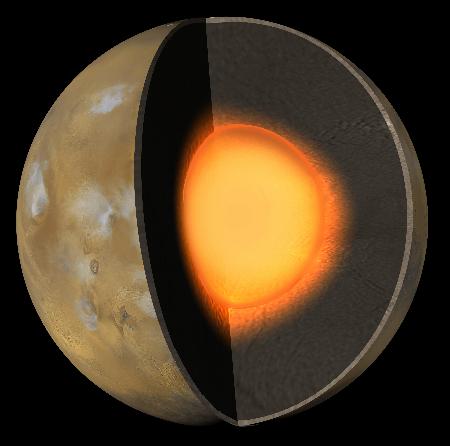
Figure 7.2 below - Global Dust Storms Surface features are obliterated during one of Mars's global dust storms, as seen by the Hubble Space Telescope in 2001. The storm lasted about three months.
Image Credit: NASA/HST

Figure 7.3 below - Dust Devils on Mars: The Spirit rover spied dust devils in Gusev crater in 2005 during the spring and summer seasons.
Image Credit: NASA

Figure 7.4 below - Viking's View of Mars: The largest canyon in the Solar System cuts a wide swath across the face of Mars. Named Valles Marineris, the grand valley extends over 3,000 kilometers long, spans as much as 600 kilometers across, and delves as much as 8 kilometers deep. By comparison, the Earth's Grand Canyon in Arizona, USA is 800 kilometers long, 30 kilometers across, and 1.8 kilometers deep. The origin of the Valles Marineris remains unknown, although a leading hypothesis holds that it started as a crack billions of years ago as the planet cooled. Recently, several geologic processes have been identified in the canyon. The mosaic was created from over 100 images of Mars taken by Viking Orbiters in the 1970s.
Caption and Image Credit: NASA

Figure 7.5 below - Olympus Mons: The largest of the volcanoes in the Tharsis Montes region, as well as all known volcanoes in the solar system, is Olympus Mons. Olympus Mons is a shield volcano 624 km (374 mi) in diameter (approximately the same size as the state of Arizona), 25 km (16 mi) high, and is rimmed by a 6 km (4 mi) high scarp. A caldera 80 km (50 mi) wide is located at the summit of Olympus Mons. To compare, the largest volcano on Earth is Mauna Loa. Mauna Loa is a shield volcano 10 km (6.3 mi) high and 120 km (75 mi) across. The volume of Olympus Mons is about 100 times larger than that of Mauna Loa. In fact, the entire chain of Hawaiian islands (from Kauai to Hawaii) would fit inside Olympus Mons! This color mosaic of Olympus Mons volcano on Mars is from the Viking 1 Orbiter. The mosaic was created using images from orbit 735 taken 22 June 1978. The complex aureole terrain is visible at the top of the frame. North is up. (Viking 1 Orbiter MH20N133-735A)
Caption and Image Credit: NASA

Figure 7.6 below - Layers at the Base of Mount Sharp: A chapter of the layered geological history of Mars is laid bare in this postcard from NASA's Curiosity rover. The image shows the base of Mount Sharp, the rover's eventual science destination. This image is a portion of a larger image taken by Curiosity's 100-millimeter Mast Camera on Aug. 23, 2012. Scientists enhanced the color in one version to show the Martian scene under the lighting conditions we have on Earth, which helps in analyzing the terrain. For scale, the pointy mound in the center of the image is about 1,000 feet (300 meters) across and 300 feet (100 meters) high.
Caption and Image Credit: NASA
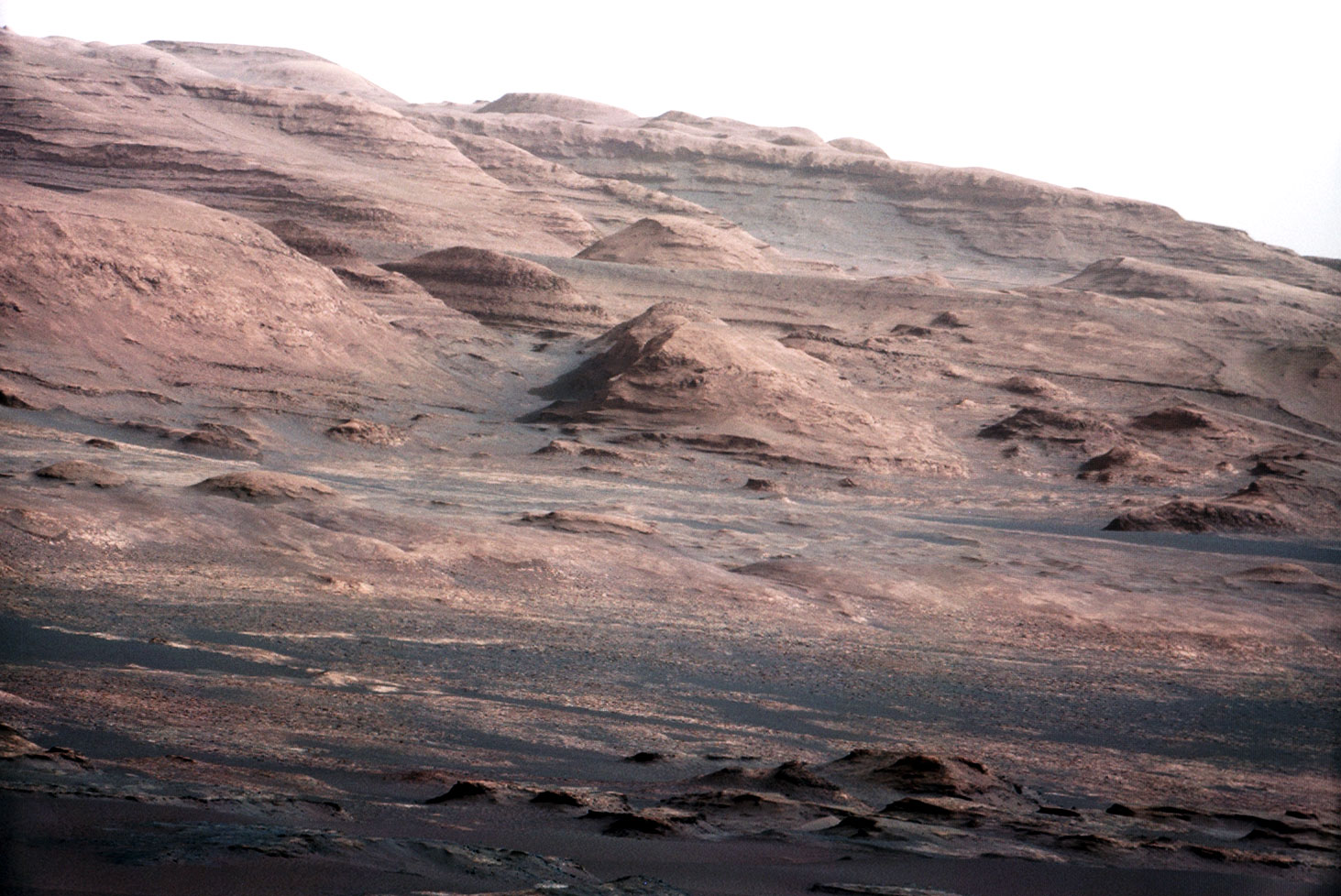
Figure 7.7 below - Egg Rock - a Meteorite on Mars: The dark, smooth-surfaced object at the center of this Oct. 30, 2016, image from the Mast Camera (Mastcam) on NASA's Curiosity Mars rover was examined with laser pulses and confirmed to be an iron-nickel meteorite. The grid of shiny points visible on the object resulted from that laser zapping by Curiosity's Chemistry and Camera (ChemCam) instrument. The meteorite is about the size of a golf ball. It is informally named "Egg Rock," for a site in Maine. The scene is presented with a color adjustment that approximates white balancing, to resemble how the rocks and sand would appear under daytime lighting conditions on Earth. The image includes a scale bar of 5 centimeters (about 2 inches).
Caption and Image Credit: NASA
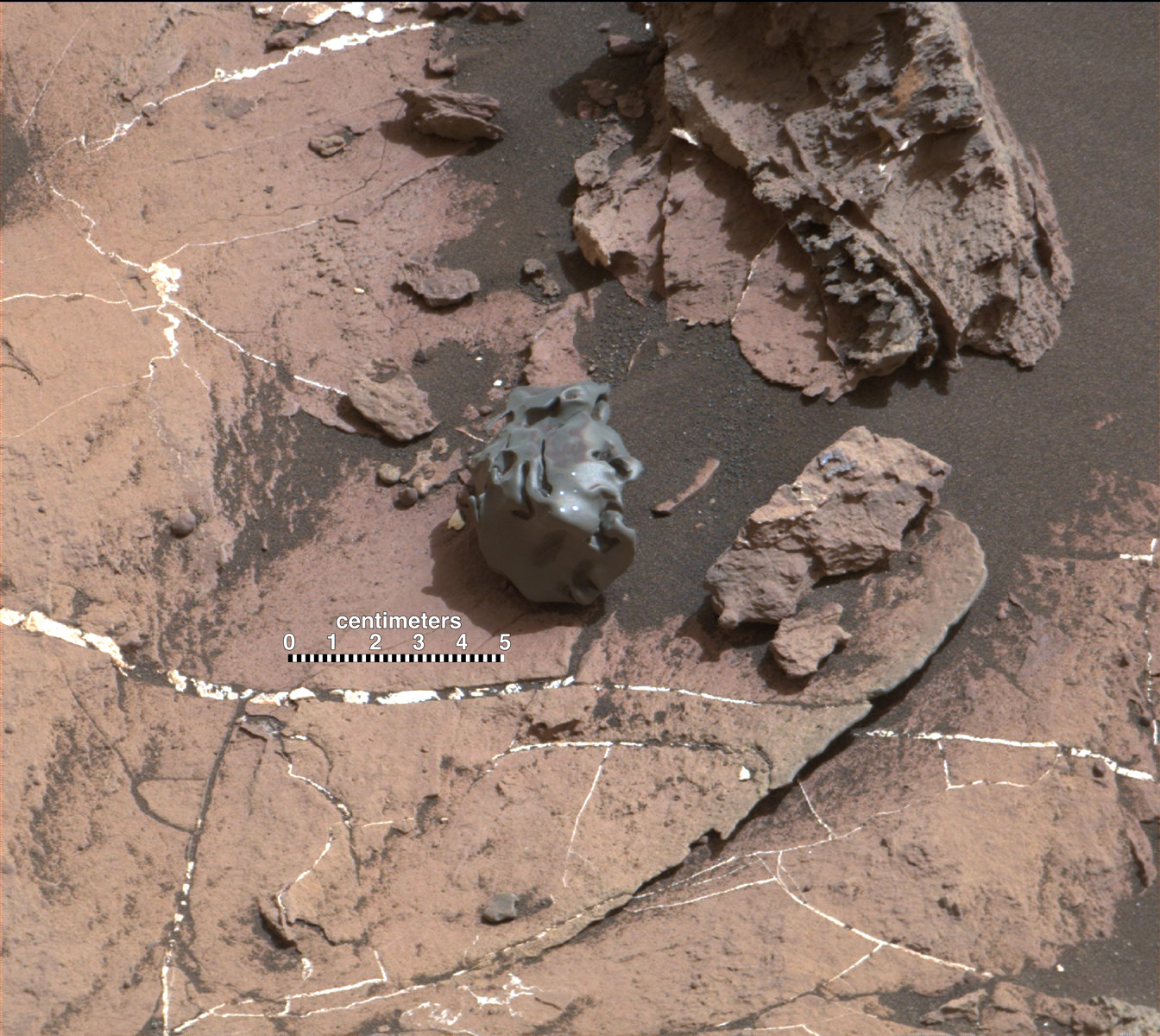
Figure 7.8 below - The Colour of Mars: 'Raw,' 'Natural' and 'White-Balanced' Views of Martian Terrain - These three versions of the same image taken by the Mast Camera (Mastcam) on NASA's Mars rover Curiosity illustrate different choices that scientists can make in presenting the colors recorded by the camera. The left image is the raw, unprocessed color, as it is received directly from Mars. The center rendering was produced after calibration of the image to show an estimate of "natural" color, or approximately what the colors would look like if we were to view the scene ourselves on Mars. The right image shows the result of then applying a processing method called white-balancing, which shows an estimate of the colors of the terrain as if illuminated under Earth-like, rather than Martian, lighting. The image was taken by the Mastcam on Sol 19 of Curiosity's mission on Mars (Aug. 23, 2012), using only the camera's red-green-blue Bayer filters. It looks south-southwest from the rover's landing site toward Mount Sharp.
Caption and Image Credit: NASA/JPL-Caltech/MSSS
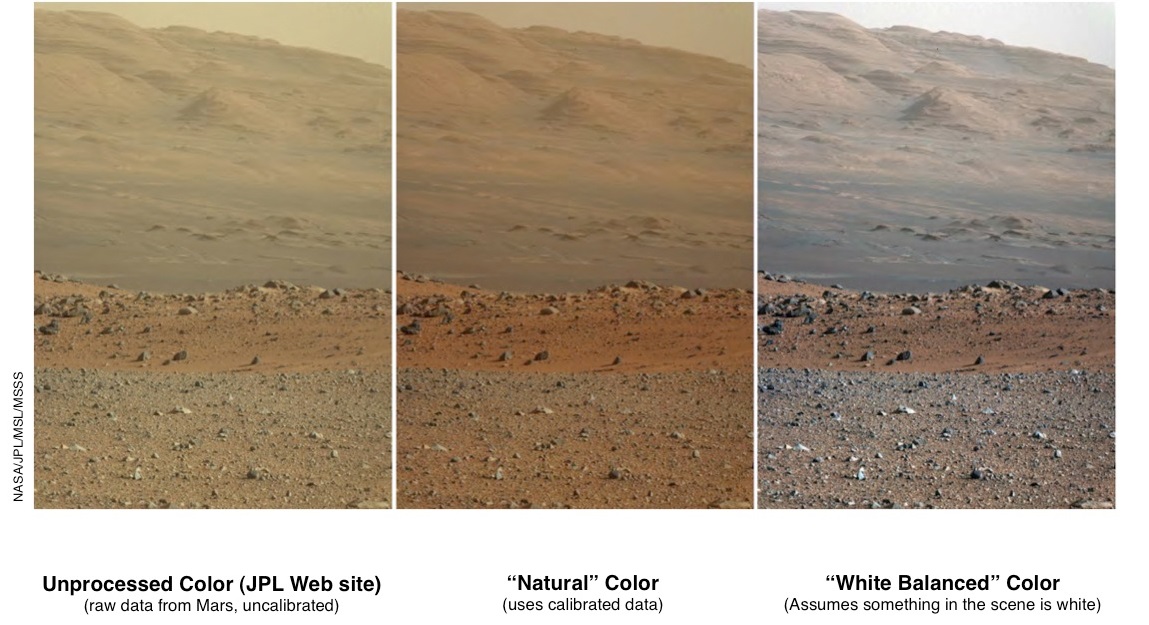
Figure 7.9 below - Three Generations of Mars Rovers: Two spacecraft engineers stand with a group of vehicles providing a comparison of three generations of Mars rovers developed at NASA's Jet Propulsion Laboratory, Pasadena, Calif. The setting is JPL's Mars Yard testing area. Front and center is the flight spare for the first Mars rover, Sojourner, which landed on Mars in 1997 as part of the Mars Pathfinder Project. On the left is a Mars Exploration Rover Project test rover that is a working sibling to Spirit and Opportunity, which landed on Mars in 2004. On the right is a Mars Science Laboratory test rover the size of that project's Mars rover, Curiosity, which landed in 2012. The engineers are JPL's Matt Robinson, left, and Wesley Kuykendall. The California Institute of Technology, in Pasadena, operates JPL for NASA.
Caption and Image Credit: NASA/JPL-Caltech
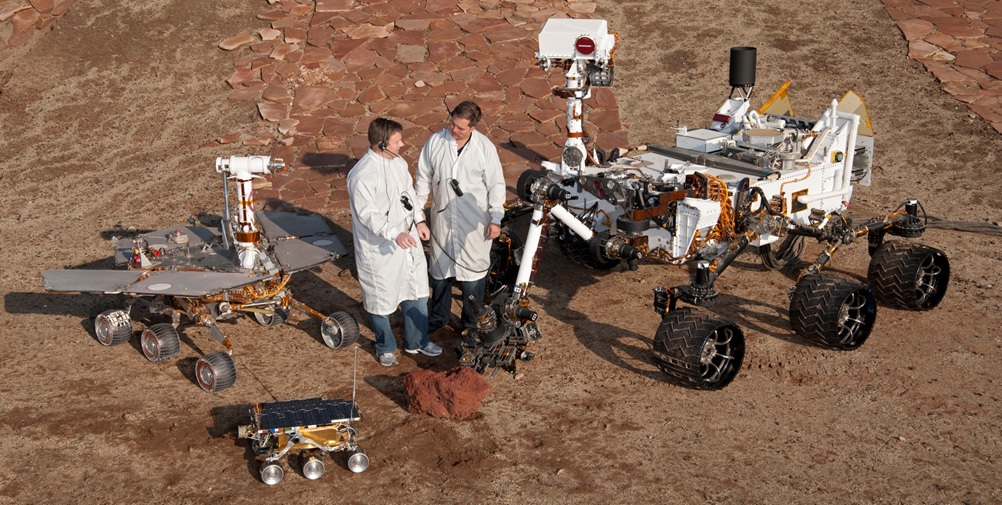
8. Features of the Terrestrial Planets
The four terrestrial planets have many features in common:
- Nickel-iron core, mantle and crust
- In other words, they are all rocky and have solid surfaces.
- Smaller than the gas giants.
- They orbit closer to the Sun than the gas giants, which orbit further out. This pattern, once thought to be well understood, does not seem to be consistent with other stellar systems in which gas giants orbit very close to their parent stars.
- Few moons or none at all.
- No rings.
Figure 8.1 below - The Terrestrial Planets: Earth, Venus, Mars and Mercury shown to scale.
Image Credit: Creative Commons Licence

9. The Asteroid Belt and Inner Asteroids
The asteroid belt is a torus-shaped region in the Solar System, located roughly between the orbits of the planets Jupiter and Mars (refer Figure 9.1 below). Inner asteroids can cross the orbit of Earth, the orbit of Mars, or both orbits. Those with Earth-crossing orbits are referred to as near-Earth asteroids. This asteroid belt is also called the main asteroid belt or main belt to distinguish it from other asteroid populations in the Solar System such as near-Earth asteroids and Trojan asteroids.
- About half the mass of the belt is contained in the four largest asteroids: Ceres, Vesta, Pallas, and Hygiea.
- The total mass of the asteroid belt is approximately 4% that of the Moon.
- Ceres, the only object in the asteroid belt large enough to be a dwarf planet, is about 950 km in diameter.
- Vesta (the brightest asteroid), Pallas, and Hygiea have mean diameters of less than 600 km.
- The remaining bodies range down to the size of a dust particle.
- Some asteroids have moons.
- Exploration: NEAR Shoemaker touched down on the surface of 433 Eros - a “Mars crossing” asteroid; Rosetta visited comet 67P/Churyumov–Gerasimenko, and on the way visited two asteroids - 2867 Šteins and 21 Lutetia; Hayabusa2, a mission of the Japanese Space Agency to return samples from 162173 Ryugu, a near-Earth asteroid; and OSIRIS-Rex, another sample-return mission targeting 101955 Bennu. There has also been exploration of an idea to capture an asteroid.
Figure 9.1 below - The Inner Solar System: This diagram shows the Main Asteroid Belt as white dots. The Trojan, Greek and Hilda asteroids are also shown as indicated. Orbits and regions are to scale, and dots represent all the known asteroids, though the sizes of the dots are not to scale. This image is based on data found in the JPL DE-405 ephemeris, and the Minor Planet Center database of asteroids (published on July 6, 2006). The view looks down on the ecliptic plane as would have been seen on August 14, 2006. It was rendered by custom software written for Wikipedia by user Mdf, who has released the diagram into the public domain.
Caption Credit: The Planetary Society

Figure 9.2 below - Gaspra, Deimos and Phobos: This montage shows main-belt asteroid 951 Gaspra (top) compared with Deimos (lower left) and Phobos (lower right), the moons of Mars. The three bodies are shown at the same scale and nearly the same lighting conditions. Gaspra is about 17 kilometers (10 miles) long. All three bodies have irregular shapes, due to past catastrophic conditions. However their surfaces appear remarkably different, possibly because of differences in composition but most likely because of very different impact histories. The Phobos and Deimos images were obtained by the Viking Orbiter spacecraft in 1977; the Gaspra image is the best of a series obtained by the Galileo spacecraft on October 29, 1991.
Caption and Image Credit: NASA

Figure 9.3 below - Ceres in Natural Colour: This image of Ceres approximates how the dwarf planet's colors would appear to the eye. This view of Ceres, produced by the German Aerospace Center in Berlin, combines images taken during Dawn's first science orbit in 2015 using the framing camera's red, green and blue spectral filters. The color was calculated using a reflectance spectrum, which is based on the way that Ceres reflects different wavelengths of light and the solar wavelengths that illuminate Ceres. - NASA Caption.
Image Credit: NASA/JPL-Caltech/UCLA/MPS/DLR/IDA
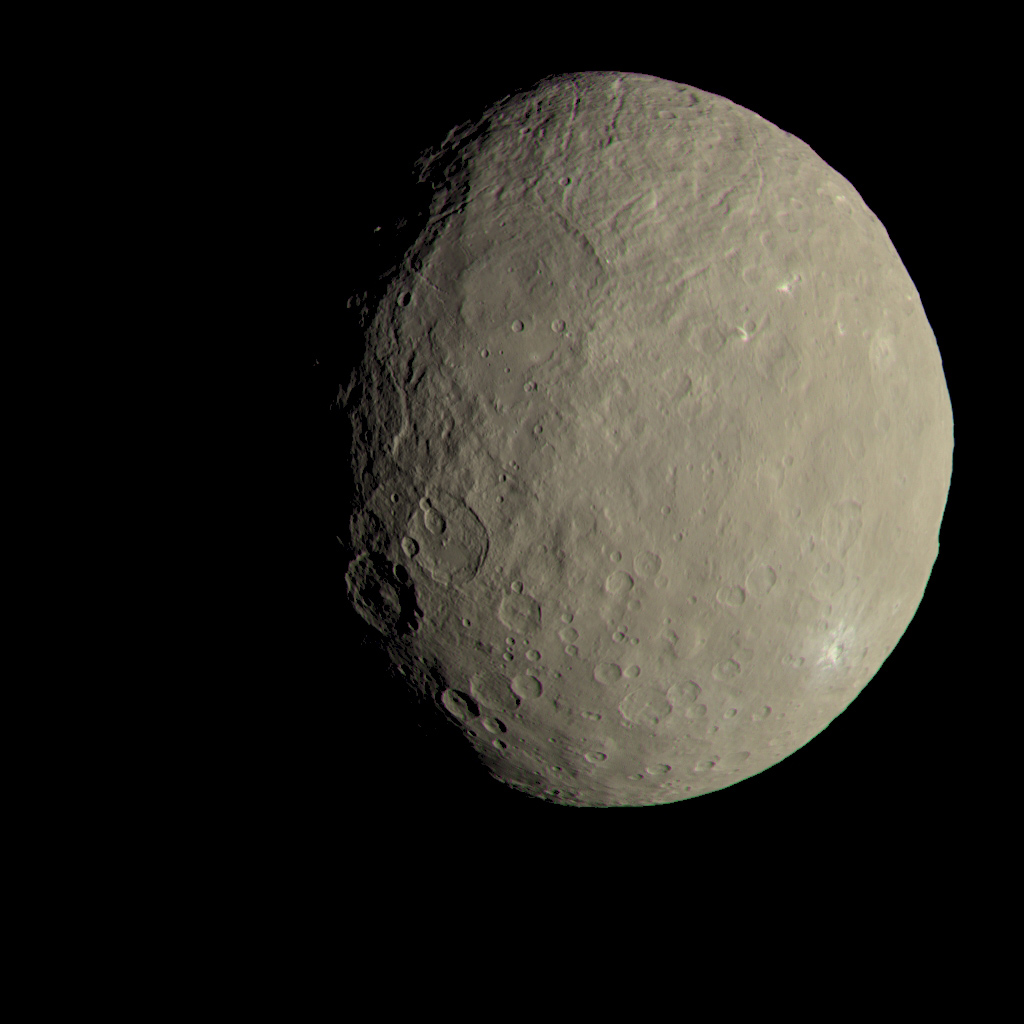
Figure 9.4 below - Vesta: NASA's Dawn spacecraft studied Vesta from July 2011 to September 2012, obtaining images of the entire surface. Also take a look at this movie of Vesta rotating.
Image Credit: NASA
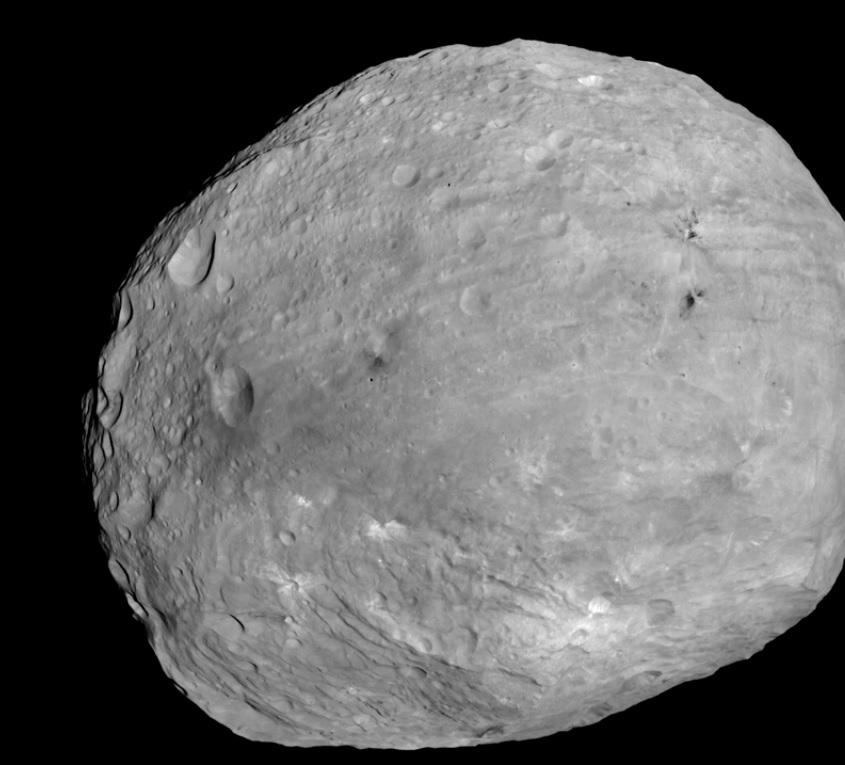
Figure 9.5 below - Ida and Dactyl: Asteroids can have moons! Here, asteroid Ida is seen with its one-kilometre diameter companion, Dactyl. Read more about Dactyl.
Image Credit: NASA
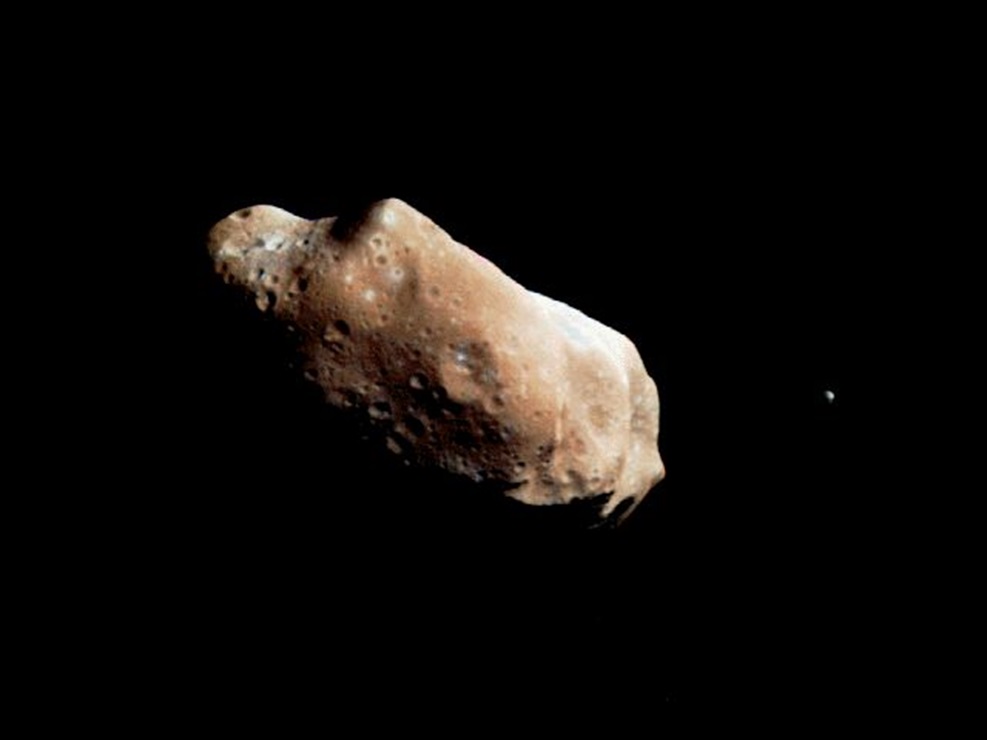
Figure 9.6 below - Asteroids compared: Vesta and a number of other asteroids are shown on the same scale.
Image Credit: NASA

10. Jupiter
Quick facts about Jupiter:
- Diameter: 143,200 km
- Average distance from the Sun: 778 million km, 5 AU
- Structure: Once thought to have a small rocky core about the size of Earth, now believed to be larger and more diffuse (refer Figure 10.1 below). The bulk of the planet is hydrogen and helium all the way up to the upper atmosphere. These gases are compressed as you go deeper, gradually changing phase from gas to liquid and, eventually, to metallic liquid! This just means that the hydrogen is under so much pressure that the electrons are separated from the nuclei (protons), thus it can conduct electricity.
- Atmosphere: Molecular hydrogen (H2) - 89.8%; helium (He) - 10.2%; with traces of methane (CH4), ammonia (NH3), hydrogen deuteride (HD), ethane (C2H6), water (H2O), and ammonia hydrosulfide.
- Length of day: A little under 10 hours
- Period of orbit: 11.86 years
- Neat stuff: Not only does the pressure increase as you go deeper into Jupiter, the temperature also increases. The liquid metallic hydrogen is thought to be the origin of Jupiter's huge magnetic field. The Great Red Spot in the atmosphere has been observed for hundreds of years, but other storm systems are continually changing. For scale, 11 Earths would fit side-by-side across the diameter of Jupiter.
- Moons: At least 79 known moons. The four largest (the Galilean moons) are Io, Europa, Ganymede and Callisto.
- Trojan Asteroids: Jupiter was the first planet found to have Trojan asteroids, that orbit the Sun before and after the planet. Refer Figure 9.1 above. Jupiter's binary Trojan asteroids, Patroclus and Menoetius, are discussed here.
- Exploration: Dates supplied are launch dates.
Current Missions
Juno - NASA Orbiter to Jupiter (2011)
Past Missions
Cassini - NASA/ESA Mission to Saturn via Jupiter (1997)
Ulysses - NASA/ESA Mission to study the solar wind via Jupiter (1990)
Galileo Orbiter - NASA Mission to Jupiter (1989)
Galileo Probe - NASA Mission to Jupiter (1989)
Voyager 1 - NASA Mission to Jupiter and Saturn (1977)
Voyager 2 - NASA Mission to Jupiter, Saturn, Uranus, Neptune, and beyond (1977)
Pioneer 11 - NASA Jupiter flyby (1973)
Pioneer 10 - NASA Jupiter flyby (1972)
Future Missions
JUpiter ICy moons Explorer (JUICE) - ESA Jupiter Orbiter / Ganymede-Callisto-Europa Multiple Flyby Mission (2022)
Europa Clipper - NASA Jupiter Orbiter / Europa Multiple Flyby Mission (2023-2025)
Figure 10.1 below - Three phases of Jupiter: . Liu et al. propose that the present-day internal structure of Jupiter is the result of a giant impact between the young planet and a planetary embryo that had roughly the mass of Uranus. (a) In the authors’ model, before the impact, both Jupiter and the embryo contained a dense central core of heavy elements and a hydrogen–helium envelope. The colours represent the density of material, ranging from low (white) to high (dark orange). (b) Just after the impact, the two cores merged and partially mixed with the planet’s envelope to produce a dilute core. (c) After subsequent evolution, the dilute core remained, but was partially eroded into the envelope, causing the envelope to be enriched in heavy elements.
Image Credit: Nature article about paper by Liu, S.-F. et al. Nature 572, 355–357 (2019).

Figure 10.2 below - Earth's and Jupiter's moons compared: This diagram shows the sizes and planet-moon separations, all on the same scale, of the Earth and the Moon, and Jupiter with its four largest moons, Io, Europa, Ganymede and Callisto (click the image to enlarge).
Image Credit: Diagram by Lesa Moore

Figure 10.3 below - The Great Red Spot: Jupiter's Great Red Spot has persisted for hundreds of years, though it has not looked exactly the same over the whole period. The images below show a reduction in size over a period of almost twenty years.
Image Credit: NASA/STScI
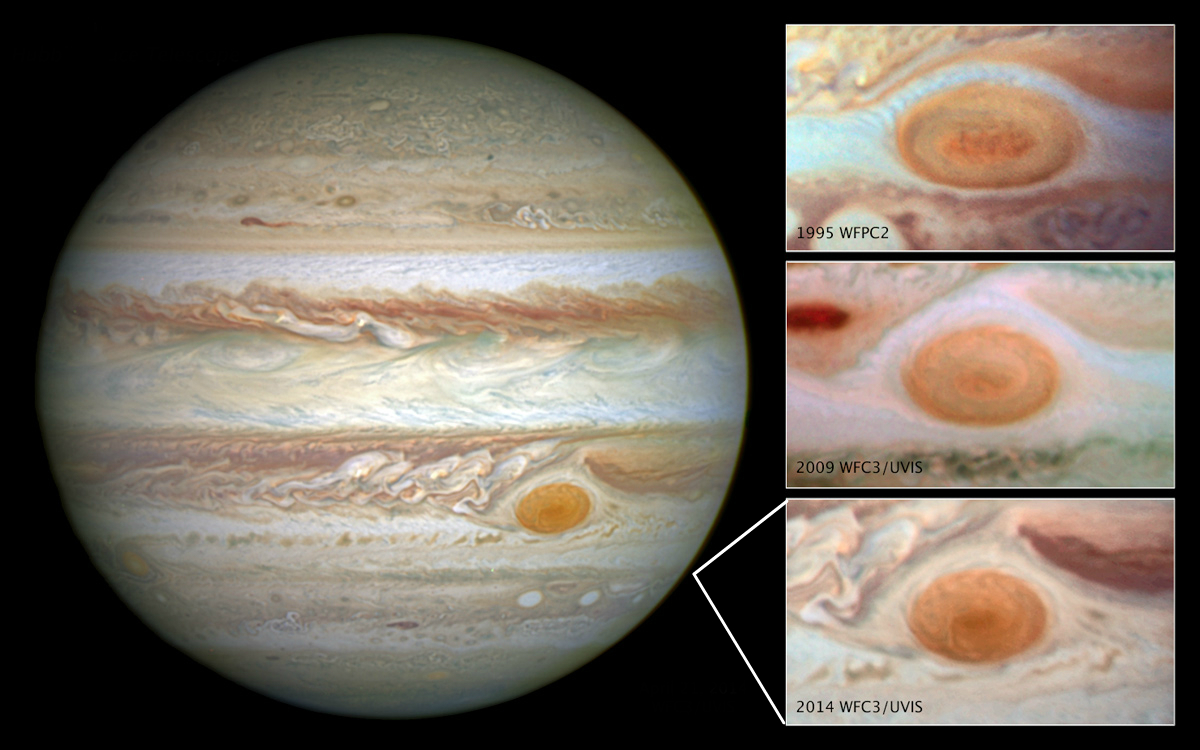
11. Saturn
Quick facts about Saturn:
- Diameter: 120,000 km
- Average distance from the Sun: 1,400 million km, 9 AU
- Structure: Pretty similar to Jupiter, though the core is probably more dense.
- Atmosphere: Molecular hydrogen (H2) - 96.3%; helium (He) - 3.25%; with traces of methane (CH4), ammonia (NH3), hydrogen deuteride (HD), ethane (C2H6), ammonia hydrosulfide and water.
- Length of day: 10.6 hours
- Period of orbit: 29.5 years
- Neat stuff: Saturn's average density is less than that of water. If you had a big enough bathtub, Saturn would float! Saturn has the biggest, brightest rings in the Solar System. The rings are composed mainly of water ice particles that range in size from about the size of a small house down to the size of dust particles. The main ring system is about 275,000 km in diamater (three-quarters of the distance between the Earth and the Moon) but only about one kilometre thick.
- Moons: At least 82 known moons. Take the links to read about the more interesting ones: Mimas, Enceladus, Tethys, Dione, Rhea, Titan, Hyperion, Iapetus, Phoebe, Epimetheus & Janus, Pan, Atlas, Propeller Moons.
- Exploration: Cassini - NASA/ESA Mission to Saturn; Huygens - NASA/ESA Mission to Saturn's satellite Titan; Voyager 1 - NASA Mission to Jupiter and Saturn; Voyager 2 - NASA Mission to Jupiter, Saturn, Uranus, Neptune, and beyond; Pioneer 11 - NASA Saturn flyby (1979).
Figure 11.1 below - Diagram of Saturn's Satellites and Ring Structure: The units of measurement along the bottom horizontal scale are Saturn radii (Rs). SOI refers to Cassini's "Saturn Orbital Insertion" manoeuvre which took place in 2004. Saturn's largest moon, Titan, is further out than the extent of the bottom diagram. Click on the image to enlarge.
Image Credit: David Seal, JPL, NASA

Figure 11.2 below - Ring Orientation: During Saturn's near-30-year orbit, its axis maintains the same orientation relative to the distant stars as it orbits the Sun. Its axial tilt of 27 degrees means that, from Earth (relatively close to the Sun), we see alternately the southern side of the rings, the rings edge-on, the northern side of the rings and then back to edge-on again. This image shows scenes over seven-and-a-half years.
Image Credit: NASA, STScI
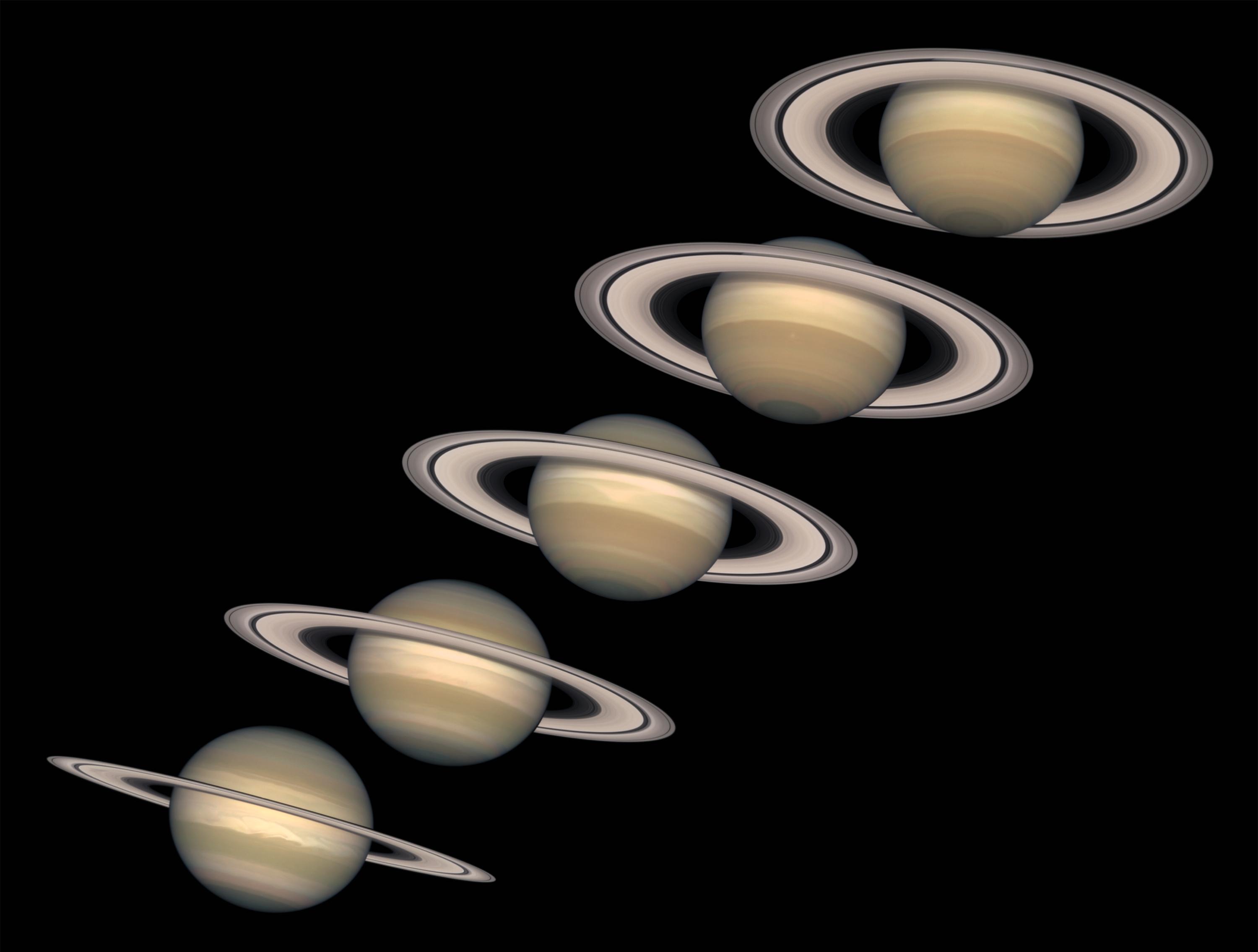
Figure 11.3 below - Ring Detail: Minuscule moons and lumpy bits in the rings cast shadows from the Sun when the rings are seen edge-on from Earth. The Cassini spacecraft was able to see the rings from many different directions, revealing these fascinating images.
Image Credit: NASA/Cassini

Figure 11.4 below - Saturn's Polar Hexagon: Saturn's hexagon is a persisting hexagonal cloud pattern around the north pole of Saturn. The sides of the hexagon are about 14,500 km long. The hexagon was observed by Voyager in 1981 and by Cassini in 2006.
Image Credit: NASA/Cassini
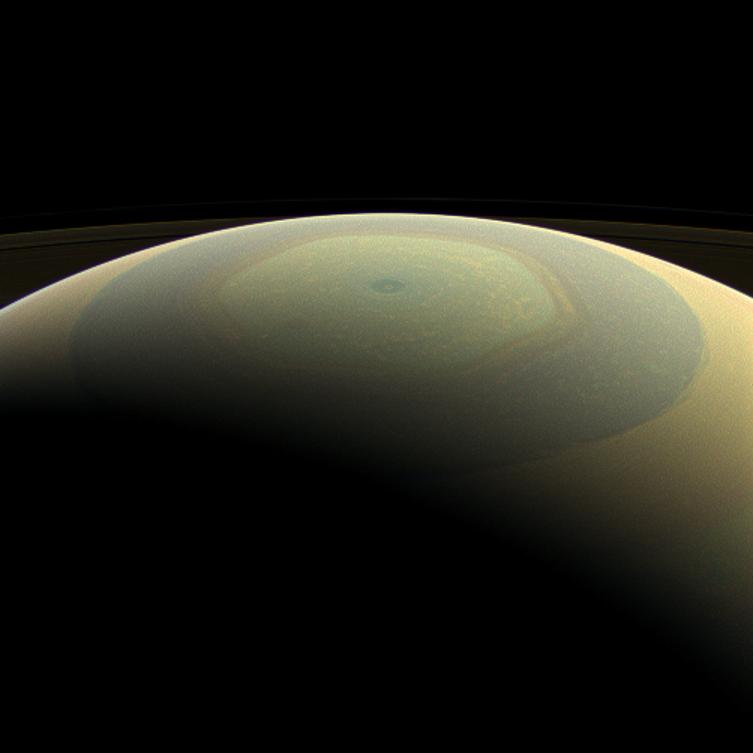
12. Uranus
Quick facts about Uranus:
- Diameter: 51,800 km
- Average distance from the Sun: 2,900 million km, 19 AU
- Structure: Three layers: a rocky silicate/iron-nickel core in the center, an icy mantle in the middle and an outer gaseous hydrogen/helium envelope.
- Atmosphere: Molecular hydrogen (H2) - 82.5%; helium (He) - 15.2%; methane (CH4) - 2.3%; traces of hydrogen deuteride (HD), ammonia ice, water ice, ammonia hydrosulfide, methane ice(?).
- Length of day: 17.24 hours
- Period of orbit: 84 years
- Neat stuff: The axial tilt of Uranus is more than ninety degrees, i.e. its spin is retrograde (the opposite direction to the spin of most planets and the orbits of the planets around the Sun). The highly inclined axis means that, during its long orbit, sometimes we see the north pole almost facing us and sometimes it is the south pole. Uranus' rings were discovered from Earth by observing the occultation of a distant star, which blinked on and off in a symmetrical pattern on either side of the planet as Uranus passed the star.
- Moons: At least 27 known moons. Take the links to read about the more interesting ones: Titania, Ariel, Umbriel, Miranda.
- Exploration: Voyager 2 - NASA Mission to Jupiter, Saturn, Uranus, Neptune, and beyond.
Figure 12.1 below - Uranus in natural colour: Voyager 2 took this image as it approached the planet Uranus on Jan. 14, 1986. The planet's hazy bluish color is due to the methane in its atmosphere, which absorbs red wavelengths of light.
Image Credit: NASA/JPL-Caltech

Figure 12.2 below - Uranus and its Rings in infrared: Uranus imaging with the Keck NIRC2 near-infrared camera on 11-12 July 2004 UT. These two images show opposite sides of the planet, with Uranus’ north pole at 4 o’clock. Each color image is a composite in which near infrared images using J (1.26 micron), H (1.62 micron), and K' (2.1 micron) filters are assigned to blue, green, and red color components respectively. This roughly approximates the view that would be available to human vision if the response of the eye could be shifted to longer wavelengths beyond red (0.7 microns). Uranus' rings appear red in color because the K' image is boosted relative to the others to reveal atmospheric features that are strongly darkened by methane absorption in this band.
Image and Caption Credit: Lawrence Sromovsky in cooperation with the W. M. Keck Observatory with funding from NASA’s Planetary Astronomy program. (SSEC, UW–Madison)

Figure 12.3 below - Uranus and Moons by the Hubble Space Telescope: Taking its first peek at Uranus, NASA Hubble Space Telescope's Near Infrared Camera and Multi-Object Spectrometer (NICMOS) detected six distinct clouds in images taken July 28,1997. The image on the right, taken 90 minutes after the left-hand image, shows the planet's rotation. Each image is a composite of three near-infrared images. They are called false-color images because the human eye cannot detect infrared light. Therefore, colors corresponding to visible light were assigned to the images. (The wavelengths for the "blue," "green," and "red" exposures are 1.1, 1.6, and 1.9 micrometers, respectively.) The rings of Uranus are extremely faint in visible light but quite prominent in the near infrared.
Image and Caption Credit: NASA/JPL/STScI
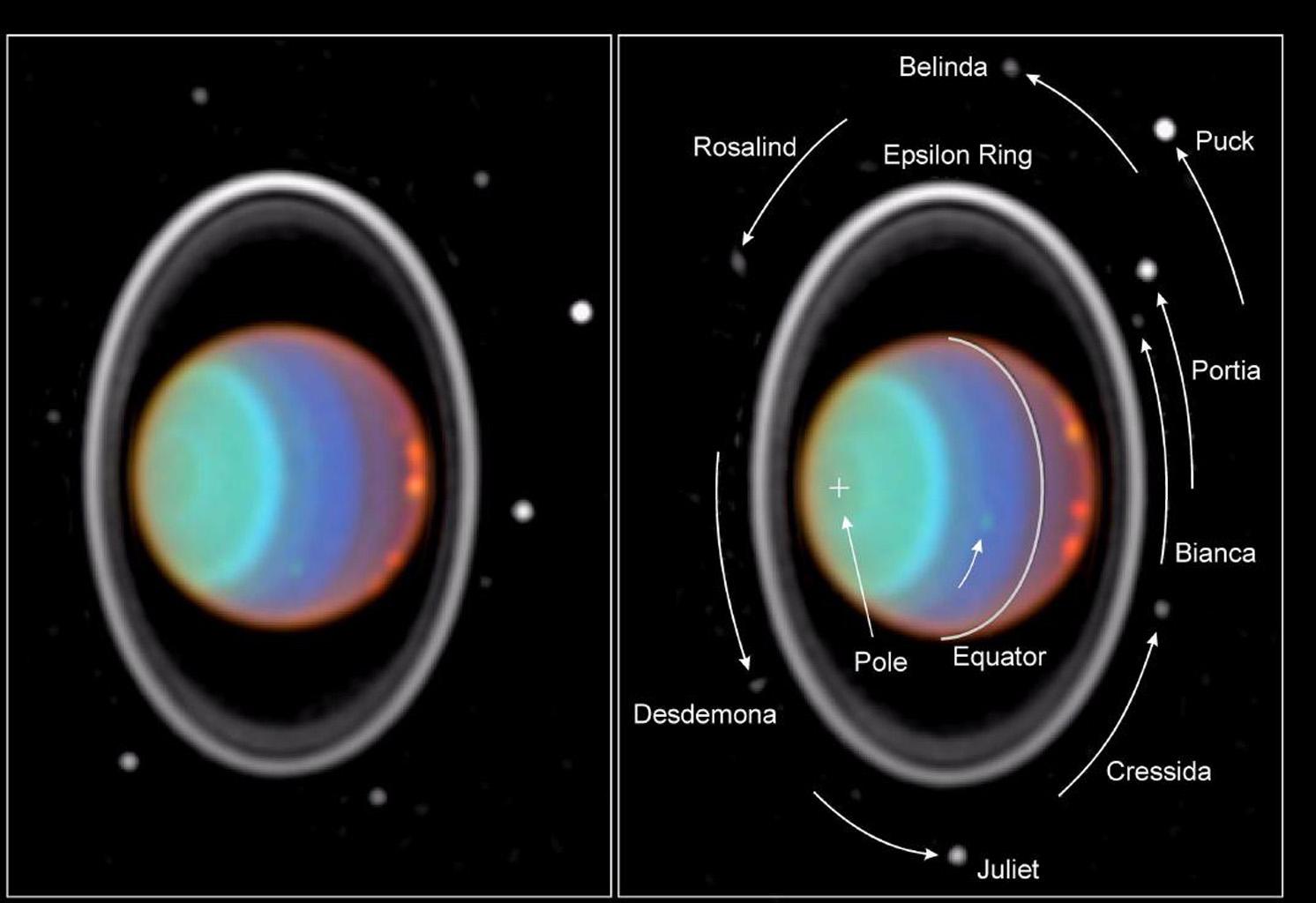
13. Neptune
Quick facts about Neptune:
- Diameter: 49,500 km
- Average distance from the Sun: 4,500 million km, 30 AU
- Structure: Like Uranus, Neptune's internal structure is differentiated between a rocky core consisting of silicates and metals; a mantle consisting of water, ammonia and methane ices; and an atmosphere consisting of hydrogen, helium and methane gas.
- Atmosphere: Molecular hydrogen (H2) - 80.0%; helium (He) - 19.0%; methane (CH4) 1.5%; traces of hydrogen deuteride (HD), Ethane (C2H6), ammonia ice, water ice, ammonia hydrosulfide, methane ice(?).
- Length of day: 16.11 hrs
- Period of orbit: 165 years
- Neat stuff: It's a pretty colour!
- Moons: At least 14 known moons including Triton.
- Exploration: Voyager 2 - NASA Mission to Jupiter, Saturn, Uranus, Neptune, and beyond.
Figure 13.1 below - Neptune: This picture of Neptune was taken by Voyager 2 less than five days before the probe's closest approach to the planet on Aug. 25, 1989. The picture shows the "Great Dark Spot" — a storm in Neptune's atmosphere — and the bright, light-blue smudge of clouds that accompanies the storm.
Image and Caption Credit: NASA/JPL-Caltech
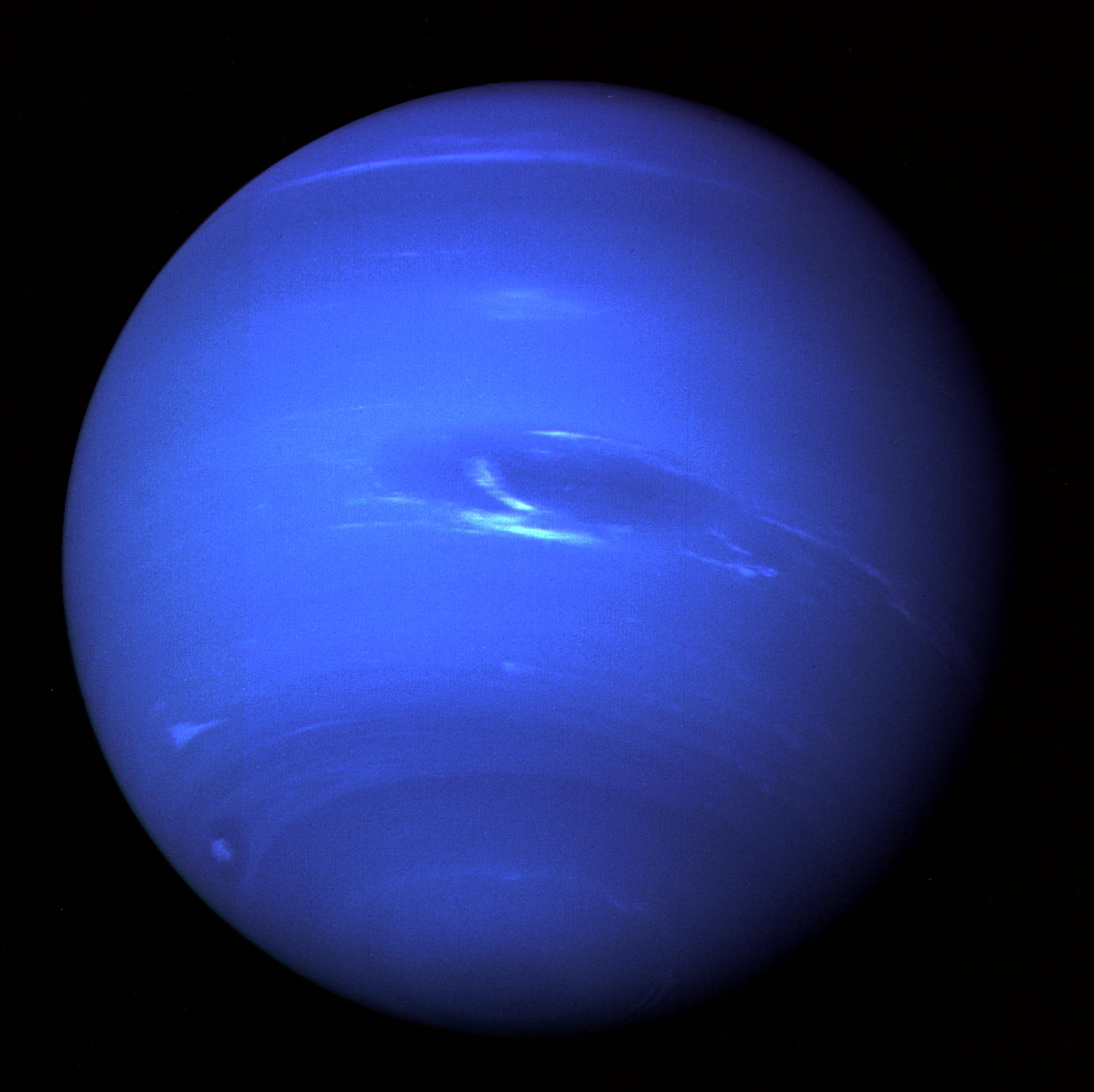
14. Features of the Gas Giants
- All are composed mostly of hydrogen and helium.
- All have rings, though those of Jupiter, Uranus and Neptune are dark and dusty.
- All have large numbers of moons.
- They are much more massive than the terrestrial planets.
Figure 14.1 below - The Gas Giants: On the same scale, Jupiter, Saturn, Uranus and Neptune compared with Earth.
Image Credit: Jupiter, Saturn, Neptune and Earth from NASA; Uranus from Lawrence Sromovsky, University of Wisconsin-Madison/ W. M. Keck Observatory; compiled by Michael Richmond.
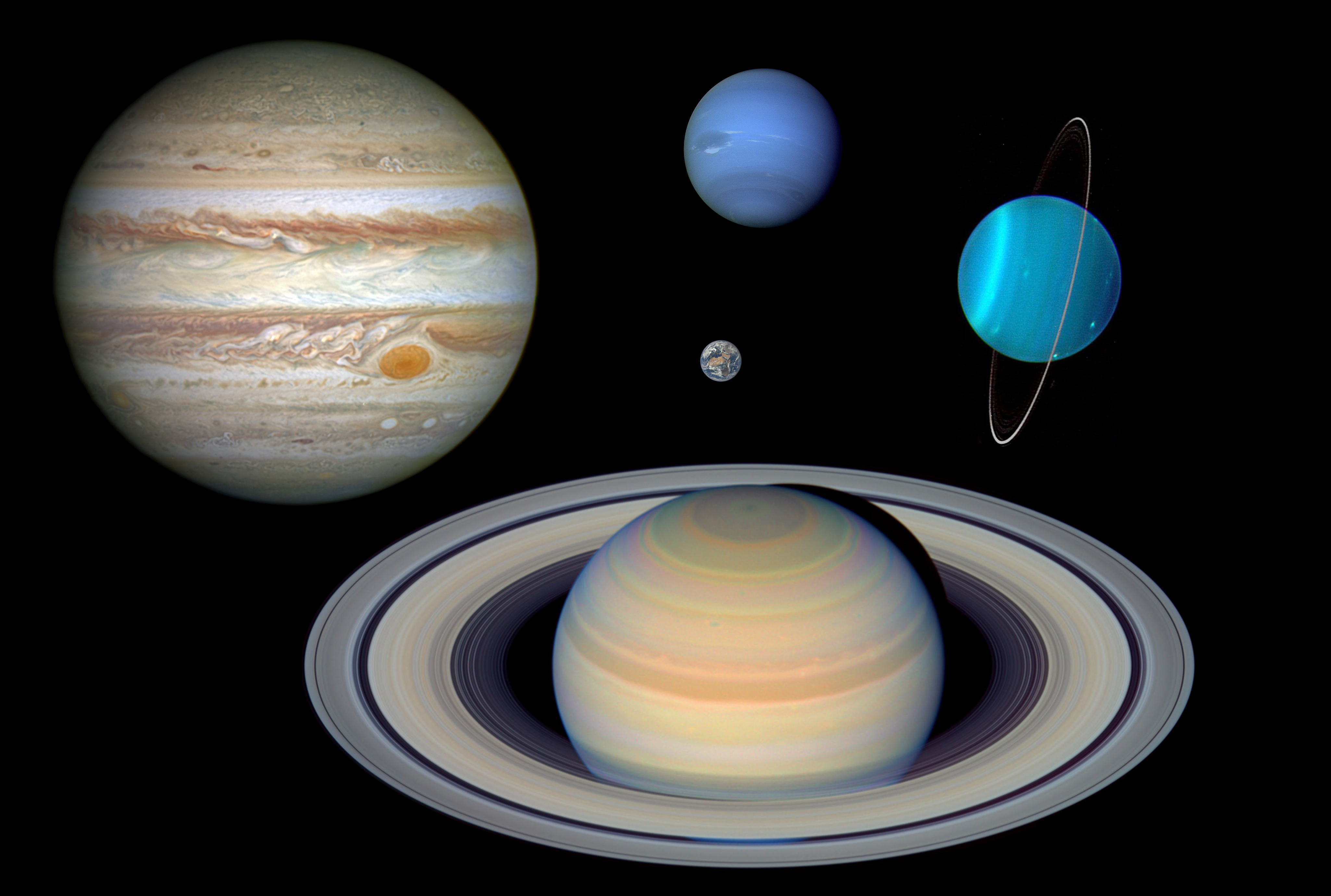
15. Dwarf Planets and Kuiper Belt Objects
The growing family of dwarf planets includes Ceres (a main-belt asteroid), Pluto, and the Kuiper Belt objects (beyond the orbit of Neptune): Haumea, Makemake and Eris. The Kuiper Belt also contains countless smaller bodies, too small to be called dwarf planets. One of these is TNO 229762 Gǃkúnǁʼhòmdímà (650 km across) and it has a moon, G!ò'é !Hú (100 km across). It was the larger body, Eris, that threw the spanner in the works for the definition of planets.
Here is a bit about ERIS:
- More massive than Pluto.
- Discovered in 2005.
- Prompted the 2006 classification of "dwarf planet".
- Has one moon, Dysnomia.
- Current distance: 96 AU (in 2020)
- Orbital period: 557 years
Figure 15.1 below - The Outer Solar System: Orbits of the main objects in the outer solar system, including Eris and Pluto. (Size of Eris not to scale.)
Image Credit: Universe Today / NASA
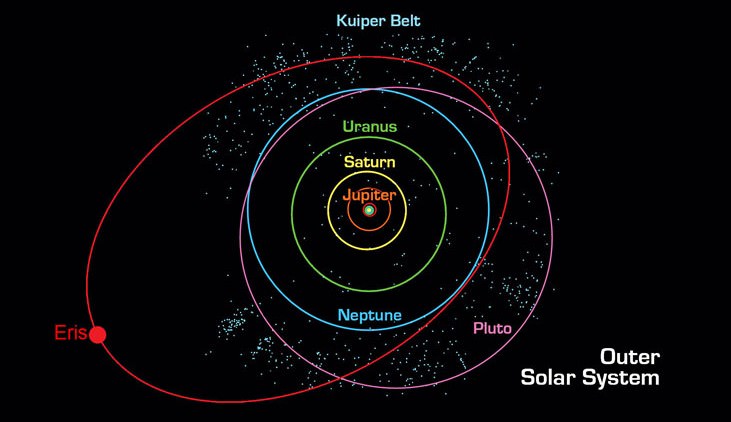
Figure 15.2 below - Relative Sizes of the Dwarf Planets: There are five confirmed dwarf planets: Pluto, Eris, Haumea, Makemake and Ceres. This illustration shows their sizes to scale.
Image Credits: Image set arranged by Lesa Moore; Makemake rendering by NASA Visualization Technology Applications and Development (VTAD); images of Pluto and Ceres by NASA/JPL; Haumea rendering by Stephanie Hoover; artist's impression of Eris by Adolph Schaller (for STScI), courtesy NASA/ESA.

16. Pluto
Quick facts about Pluto:
- Diameter: 2330 km
- Average distance from the Sun: 5,900 million km, 39 AU
- Structure: Rock and ice
- Atmosphere: Temporary atmosphere develops when nearer to the Sun.
- Length of day: 153.28 hrs
- Period of orbit: 248 years
- Neat stuff: When closest to the Sun in its orbit, it is closer to the Sun than Neptune is for a period of about 20 years. The last time this happened was 1979 to 1999. However, the bodies will never collide because the orbits are inclined in such a way that they don't intersect.
- Moons: 5 - In order of distance from Pluto, they are Charon, Styx, Nix, Kerberos, and Hydra. Charon, the largest of the five moons, is mutually tidally locked with Pluto (they always face each other), and is massive enough that Pluto–Charon is sometimes considered a double dwarf planet.
- Exploration: New Horizons - Pluto Flyby, Kuiper Belt mission (2006)
Figure 16.1 below - Pluto: This is the most accurate natural color image of Pluto taken by NASA's New Horizons spacecraft in 2015. This natural-color image results from refined calibration of data gathered by New Horizons' color Multispectral Visible Imaging Camera (MVIC). The processing creates images that would approximate the colors that the human eye would perceive, bringing them closer to "true color" than the images released near the encounter. This image was taken as New Horizons zipped toward Pluto and its moons on July 14, 2015, from a range of 35,445 kilometres.
Image and Caption Credit: NASA/Johns Hopkins University Applied Physics Laboratory/Southwest Research Institute/Alex Parker
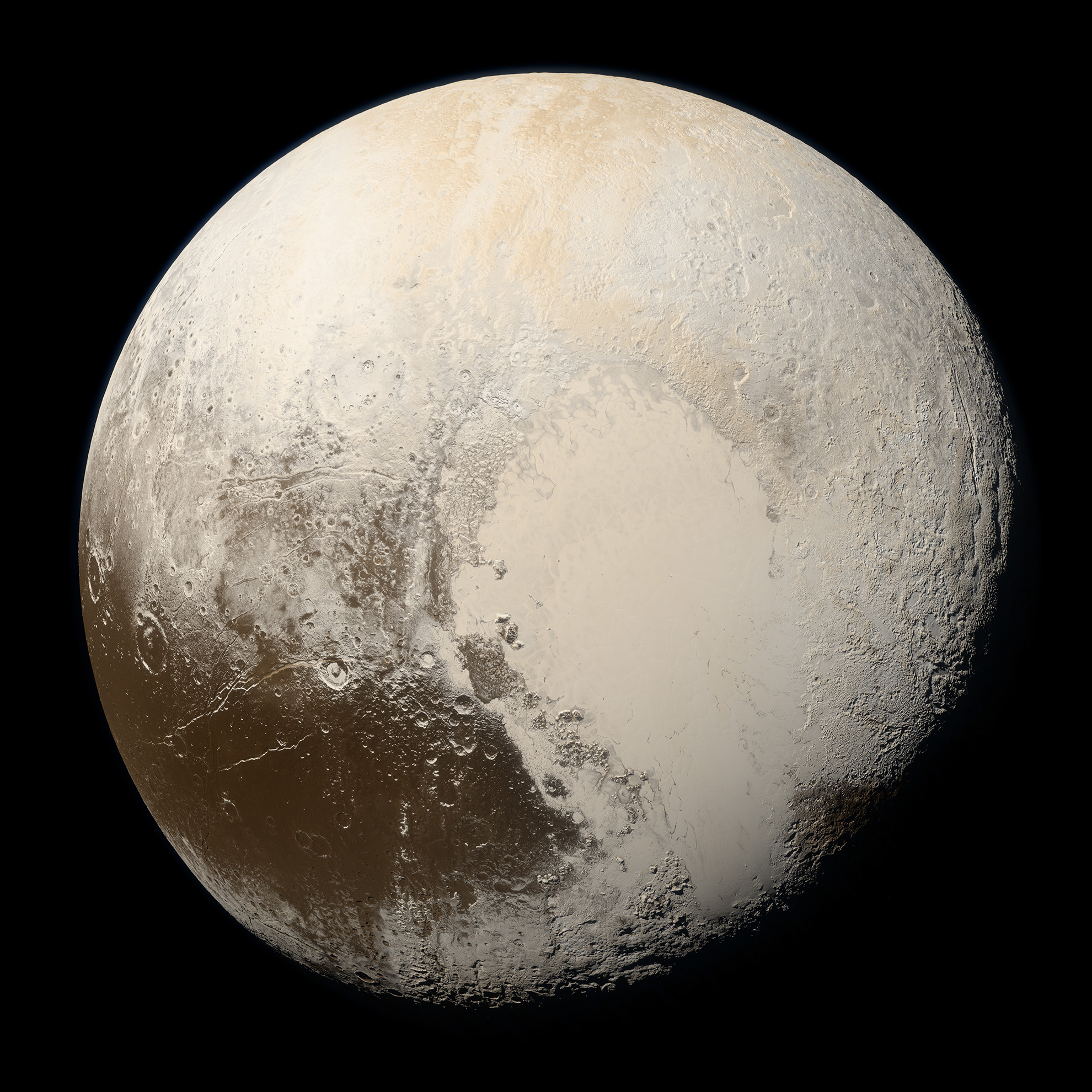
Figure 16.2 below - Pluto's Blue Sky: Pluto's haze layer shows its blue color in this picture taken by the New Horizons Ralph/Multispectral Visible Imaging Camera (MVIC). The high-altitude haze is thought to be similar in nature to that seen at Saturn’s moon Titan. The source of both hazes likely involves sunlight-initiated chemical reactions of nitrogen and methane, leading to relatively small, soot-like particles (called tholins) that grow as they settle toward the surface. This image was generated by software that combines information from blue, red and near-infrared images to replicate the color a human eye would perceive as closely as possible.
Image and Caption Credit: NASA/JHUAPL/SwRI
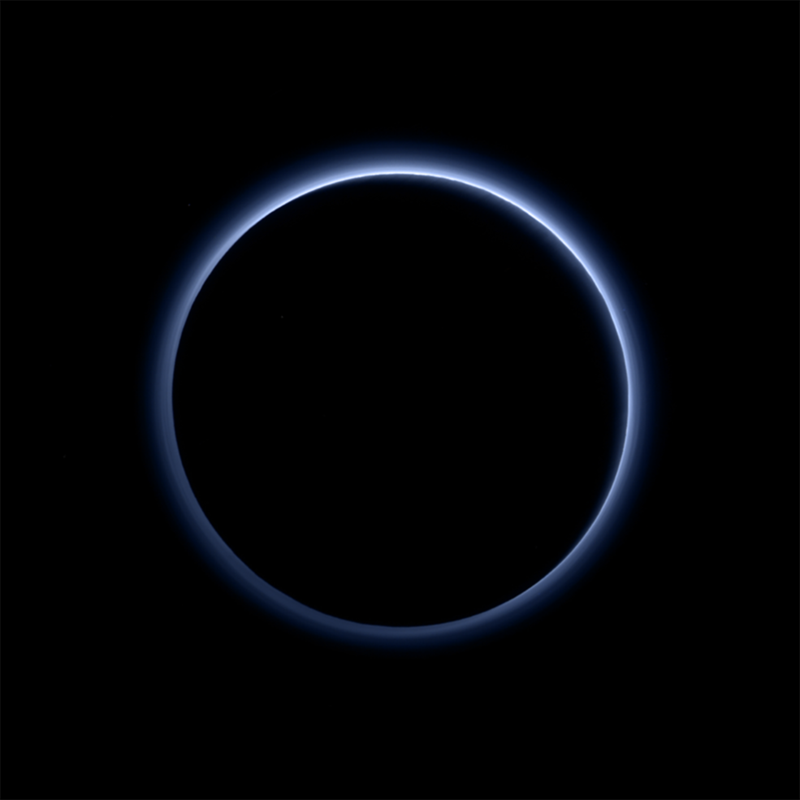
Figure 16.3 below - Pluto's Moons: This image, taken by NASA's Hubble Space Telescope, shows five moons orbiting the distant, icy dwarf planet Pluto.
Image Credit: NASA, ESA, and L. Frattare (STScI)

- Many comets are periodic and return to the inner Solar System on a regular basis. Halley's Comet is periodic and orbits the Sun once every 76 years. Some comets have much longer-period orbits. Comet Hale-Bopp's orbital period is 2,533 years, while Comet Hyakutake takes 113,782 years to orbit the Sun!
- Occasionally, a comet visits that is making its first trip from the Oort Cloud, the theorised distant repository of comets.
- Comets have been described as 'dirty snowballs', composed of ices and rock particles. As comets get closer to the Sun, the volatiles in the ices start to boil off, producing a coma.
- As the comet moves though space, the coma will leave a tail behind. However, the tail is driven away from the Sun by the solar wind (the constant stream of radiation and particles driven off by the Sun). Hence, comet tails generally point away from the Sun, regardless of the direction of motion of the comet. The tails can be more complex, though, when the combination of the comet's motion and the solar wind push streaks of material that have come away from the tumbling comet into sweeping arcs (as in Figure 17.1, below).
- Unlike meteors (small rocks or grains burning up the atmosphere), comets do not flash across the sky, but move quickly enough that their motion can be detected against the background stars over a period of half and hour or so.
- Comets are the only celestial objects that get named after their discoverer.
Figure 17.1 below - Comet McNaught: Comet McNaught, also known as the Great Comet of 2007 and given the designation C/2006 P1, is a non-periodic comet discovered on 7 August 2006 by British-Australian astronomer Robert H. McNaught using the Uppsala Southern Schmidt Telescope. It was the brightest comet in over 40 years, and was easily visible to the naked eye for observers in the southern hemisphere in January and February 2007. It has a hyperbolic trajectory, meaning that it swung past the Sun once and may never return. There is a small amount of star trailing in the image due to capture using a 60-second exposure with a camera on a fixed tripod.
Image Credit: Photo by Lesa Moore
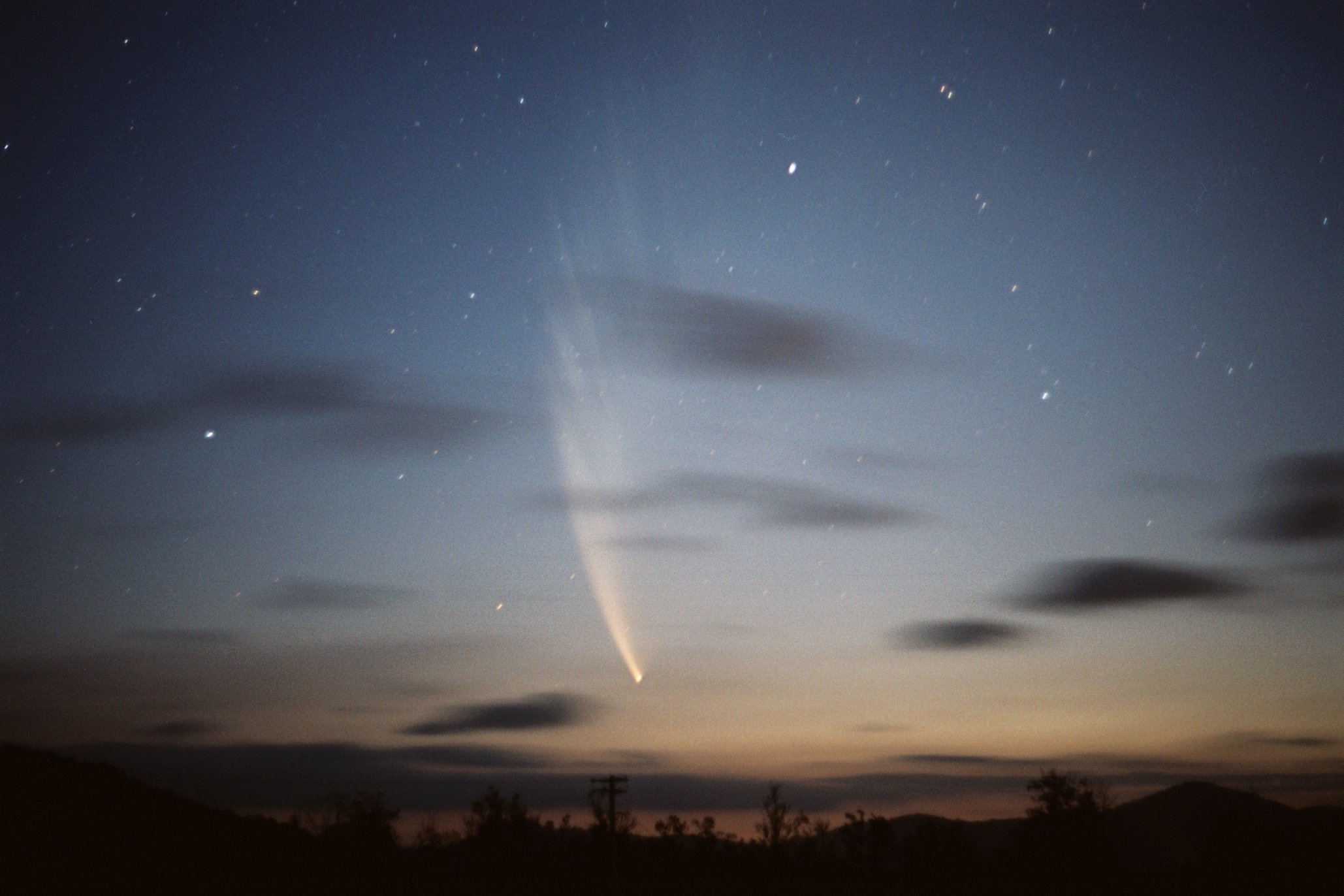
18. The Termination Shock and Beyond
The termination shock is the region in the heliosphere where the solar wind pressure (which decreases by an inverse square law as it travels away from the Sun) can no longer push through the local interstellar medium, causing the solar wind to slow down, becoming denser and hotter.
- Solar wind particles slow from 400 km/s, to less than 100 km/s at the termination shock.
- In 2005, Voyager 1, at approximately 94 AU (14 billion km) from the Sun, entered the heliosheath, the region beyond the termination shock.
- The solar wind, emanating from the Sun, creates a bubble that extends far past the orbits of the planets. This bubble is the heliosphere, shaped like a long wind sock as it moves with the Sun through interstellar space.
- The boundary between the solar wind and the interstellar wind is the heliopause, where the pressure of the two winds are in balance. This balance in pressure causes the solar wind to turn back and flow down the tail of the heliosphere. Once Voyager passes the heliopause, it will be in interstellar space.
- As the heliosphere plows through interstellar space, a bow shock forms, a bit like a bow wave from a boat in water.
Figure 18.1 below - The Heliosphere: The region of influence of the solar wind, its boundaries and effects are seen in this diagram. Refer to the more detailed descriptions above.
Image Credit: NASA

19. Orbits and Ellipses
The planets do not move in circular orbits. Their orbits are elliptical.
- An ellipse is oval-shaped.
- An ellipse has two foci. You can draw an ellipse by putting two nails, separate by a few centimetres, in a board and making a loop of string long enough to fit over the nails with some room to spare. Drop the string over the two nails, put a pen inside the loop as well and draw the ellipse by maintaining tension on the string all the way round.
- The ellipse may look almost like a circle or may be very elongated.
- In the context of orbits, the Sun is at one focus, which is always off-center.
- The degree of 'ovalness' is called eccentricity. A circle has eccentricity of zero. An ellipse has eccentricity between 0 and 1.
- Orbits of planets and asteroids are only slightly elliptical. The orbits of Pluto and Eris are rather more eccentric (0.25 and 0.44, respectively). Orbits of periodic comets have eccentricity closer to 1. Eccentricity equal to or greater than 1 indicates a parabolic or hyperbolic trajectory - i.e. the body will not return.
Additional resources: Earth and Moon Viewer and Solar System Explorer - https://www.fourmilab.ch/earthview/
Author: Lesa Moore, 19th July 2020

